Cafe Sporty
By Bandit |
Devil’s Take on the Café Racer
Story by Johnny Humble, Pics from The Devil

Sportsters have always held a special place in my heart because of the spirit they were designed to invoke with their short, choppy stroke and torquey power plant. The engine and transmission attached 50 years before the Twin Cam, and a style that is just cool as hell. The Sportster was my very first bike and I even have one in the garage today. Anyone who has ridden a Sporty knows the amount of fun involved with the bike is unmistakable. While it may be a little challenging to ride a 1981 Ironhead cross-country, it is certainly a do-able task. The problem with many of the Sporties today is that they well look the same as they have for over 50 years. How many different ways can the Company spray it black? The Devil agreed, and when he took on his latest build, he wanted to build the bike that would handle the power of the engine while still giving the rider the option to split lanes, carve canyons, or rape and pillage in style and comfort! Actually, to hell with comfort, this was all about how bad assed it would look. Enter the Café Racer.

Willie G. released the Café Racer styled Sportster in 1977 and the bike became a specialty that people either loved or hated. More people liked it compared to the boat tail designed original Superglide, but it didn’t take off quite like the company expected. Many of the Europeans have taken the café racer to the next level, but here in America, the style seems to fall behind. Recently at shows I have noticed a resurgence of the old flat track-styled café racer.

Low stance combined with a forward leaning aggression, the café racer looks bad ass like a badger. No one fucks with a badger! Even bears are scared of the badger, that’s how the café racer looks when it’s parked next to a Big Twin. The bike is low and lean, ready to strike at any moment. I can personally attest to the fact that riding a bike with a forward, aggressive position can cause you to drive like a fucking asshole!

Bandit recently sent me the following excerpt from an e-mail he received from Kent Weeks, The Lucky Devil. You see, the closer we get to shows, the busier Kent gets, so face to face interaction presents too many challenges via scheduling and such, hence the e-mail diatribe:
“here is a couple shots of a little sporty cafe custom job I just wrapped up today. I modified and mounted the tank, coil/ign brackets, fabricated the tail light/ plate mount bracket, reworked the rear section of the frame, shaped an aluminum tail section and painted it black on black with black accents, ( sounds easy when you say it like that hehehe! ) anyway I thought you might get a kick out of it.”
Fuck yeah we got a kick out of it…the bike is sick as hell. I love the way it looks fast and useable at the same time. Can you see yourself splitting lanes on the mean bastard? Give Kent a call at Lucky Devil’s Custom Cycles; he’d gladly help you out. Hell, you might even get to keep your soul.

Bonneville Report
By Bandit |

It took all day to get registered and inspected, but they now know what to do. In fact here’s the to-do lists for both the Peashooter and the Munro Special:

1. Kill Switch & Cable
2.Fuel line fire-retardant cover
3. Safety wire on axles bolts
4. Place racing identification numbers on rear fender

Bandit’s Peashooter To Do’s:
1. Put fork stops on bars
2. Kill switch & cable
3. Lube throttle cable
4. Add fuel line fire-retardant cover
5. Attach racing number identification plate. 6″x8″. Class #’s 3″x1″

Bandit reports: Hey, we blew the headgasket right after starting the Peashooter for the first time. No problem, theboys from Speed Deacon Hawaii are taking the engine apart then, we’ll rebuild anew gasket.


Bonneville 2007 Effort, Chapter 6
By Bandit |

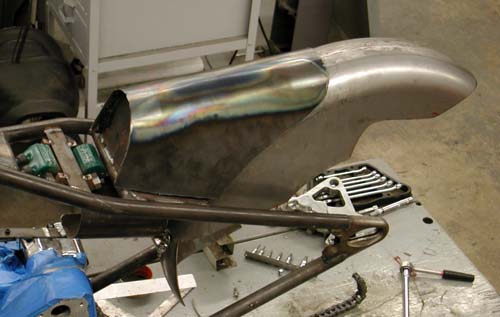
Mentally I’ve kicked off this chapter a thousand times. I come up with one lead after another to characterize my feelings at this construction juncture. I still feel two months behind schedule and scrambling. On one side side we’re making real progress, on the other, well you’ll see.
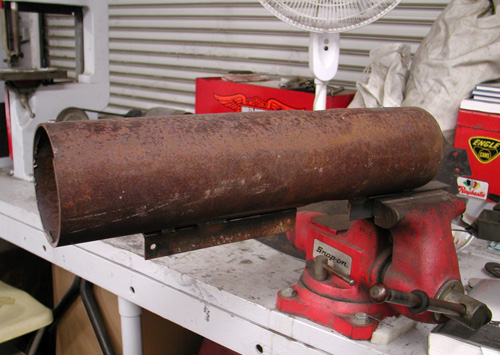
Last chapter we began bending our seat back form. We pulled it over a chunk of rusting tubing and kinked it the first time out. We welded angle iron on the tubing bottom for gig and worked the 16-guage, mild steel sheet metal again using heat from a rosebud torch. It worked better. We beat, bent, ground and formed for a day. Jeremiah, a young, local, building contractor, has a master’s touch when it comes to grinding. I’m too impatient and heavy handed.

We worked it and worked it. I used packing straps to pull it into place and more heat. Then we welded chunks of small ¾ inch angle iron to hold it down. With Jeremiah’s help, it was coming together. Under the seat I intended to install wiring connection boards or fuze holders and circuit breakers. I wanted to prepare for accessible and easy-to-locate connections for quick salt repairs. I spoke to Arron Wilson about nitrous system. He’s run nitrous for over 15 years and suggested that we keep the system as simple as possible, but Berry Wardlaw, the god of Panhead power, from Accurate Engineering had the fortune to consult with the gods of nitrous on the east coast.
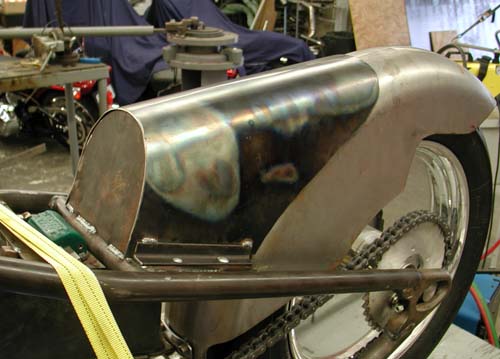
“Wow, that was fast didn't think you would be awake yet,” Berry said. “I am bringing extra nitrous bottles with me so we can change them out. I will have the answer today about needing two. I was going to use the other bottle to help pressurize the nitrous. I am calling Keith Turk right now. He is the world’s fastest on nitrous and lives here in Alabama. Mounting will not be a problem, but make sure Tom (Rodan) ok's the bracket.”

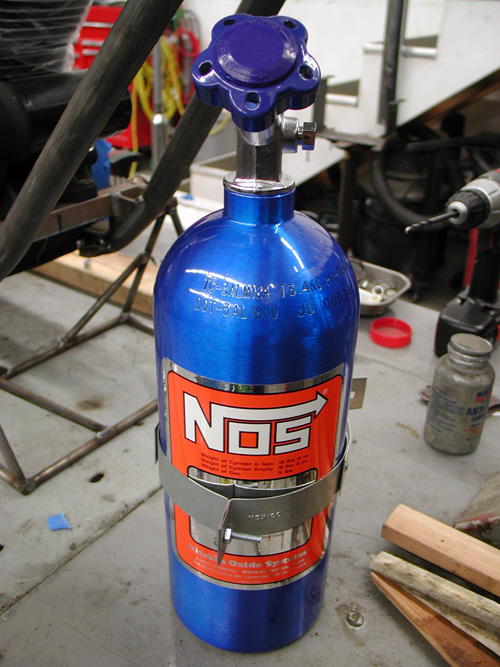
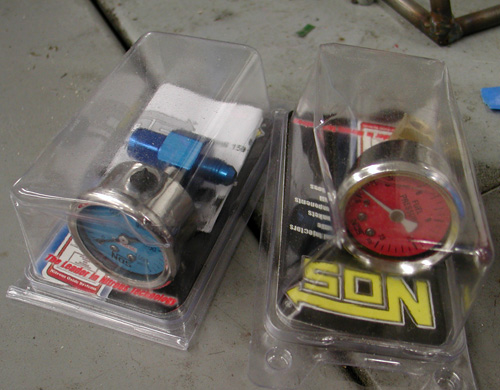
Berry spoke to the crew at Holley, who owns Hooker, and with their input, he ordered the A50558-SNOS system complete with a 5-pound bottle, two gauges, nitrous solenoids, filters, nozzles, lines, clamps, arming switch, relay, pushbutton, you name it. It’s a plumbing project and I’m glad we planned considerable space for mounting all these elements. Nitrous is not a super fuel, but a system that injects pure oxygen into the engine under pressure, which is perfect for the elevated, 4000 feet, Bonneville Salt Flats.
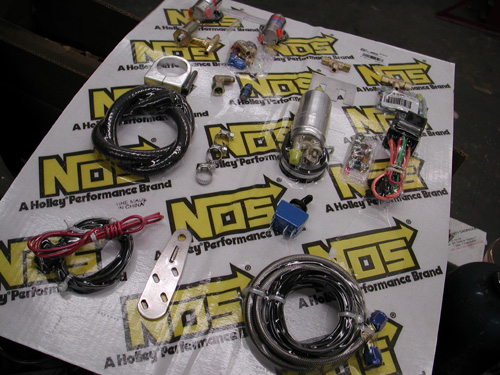
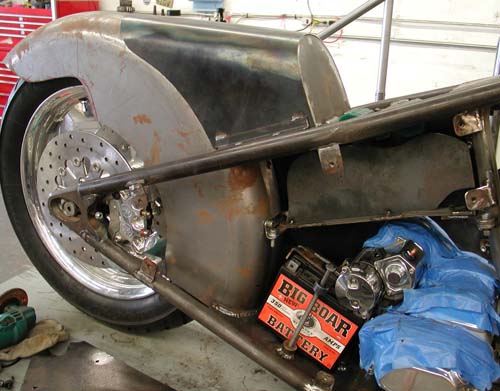
I’ll touch on the aerodynamics here. We’ve been grappling with the technology, wind tunnel research, and NASCAR design. It’s a blast to study, read and constantly filter the information against what we have in mind. I kept thinking lower and lower, since the basis of NASCAR design is to keep the air out from under the car for a couple of reasons. It creates lift and drag where it tries to squish down and slip under the vehicle.
I thought I had a plan. We were going to work with Leo DiOrio to drop the bike even further and run a belly pan under it for a pure slick surface. In addition we were considering a Hamster air damn in front of the frame to force the bike down against the ground. We were going to slam the chassis against the salt. Then one morning I received a call from Colonel Wardlaw, the Panhead commander, “Lt. Ball,” he said in his deepest voice. I was still asleep, but I always take his calls.
”Yes sir,” I mumbled trying to pry my eyes open.
”Regarding your NASCAR and wind tunnel findings, I have a problem,” he continued. “It’s a motorcycle. It must lean. Valerie must turn it off the track.”
I sat bolt upright in bed. “Goddamnit Colonel,” I spat. “You’re right. Back to the drawing board.”
We shit-canned the belly pan and shifted back to the original plan of the oil bag under the chassis, but designed in such a way to be ultimately user friendly with the wind. You’ll witness that project in the next chapter.
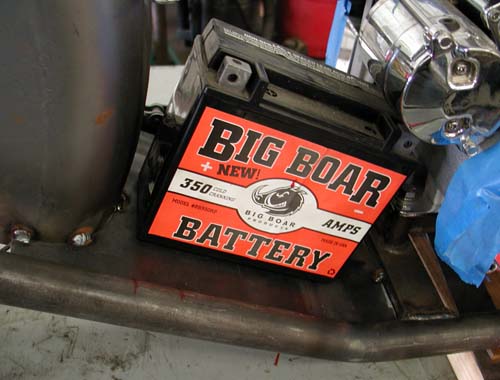
I did build a belly-pan of sorts, behind the frame cross member holding the rear transmission mounts. I made it out of ¼-inch steel plate and it reached and cupped the rear fender. This puppy worked in several ways. It grasped and mounted the front of the rear fender, and I discovered that it centered the fender perfectly over the wheel and made it as tight and solid as a battleship hull.
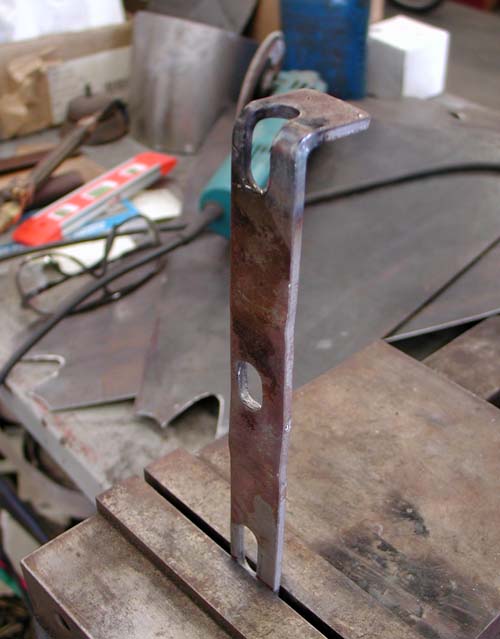
The rear pan worked also to release any air under the transmission up and away from the motorcycle. I needed to check with Vance Breeze, another motorcycle performance mastermind, but my initial goal was to point the rear of the bike like the trailing edge of a wing allowing the wind to escape the confines of the mechanical beast with the least amount of drag. In addition this heavy plate would help hold the rear end down and become our Big Boar Battery platform.
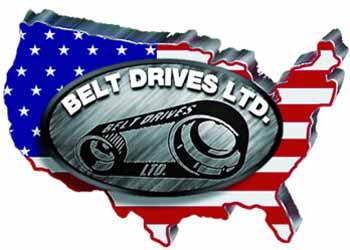

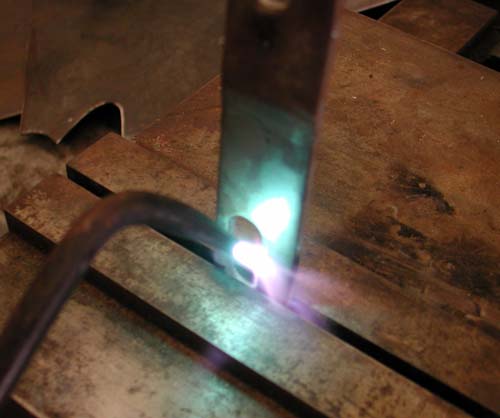
Here’s another comment from a Bikernet Television viewer: Bill Hayes here…I received an interesting email from a guy in Minnesota who saw/heard the interview I did with you for Charlie's internet biker show. The guy really took your Bonneville experience to heart…below are his comments…thought you might be interested:
I saw last weekend’s “Inner Circle” show and took an interest in Keith Ball's story about going to Bonneville with a bike he built. If you are in contact with him and he would be interested in some aerodynamic input, I’d suggest he take a look at the shape of a tear drop. As silly as that sounds it happens to be one of the least drag, most aerodynamically perfect shapes. (I dug that up after wondering why a raindrop is shaped the way it is, another of those childhood curiosities, I just couldn’t let go of, and no there was no mood altering chemicals involved.)
”He mentioned that weight on wheels seems to help with traction, he might take a look at the tail of an airplane, specifically the horizontal stabilizer. It actually produces negative lift (downward force) to counteract the weight of the airplane that is out in front of the wing (ie. the nose). He mentioned that he can’t put a fairing around the bike, but I think that with a combination of tweaks, including the shape of the rider, that they could come up with a good and slippery machine that sticks to the ground well.
”Some ideas would be starting at the front of the bike at the first part that feels the air (such as the fender), trying to direct that airflow to meet the headlight area and flow smoothly up and over the rider (shape of helmet, seating position?) and around the bike and rider with the same slippery idea. Also, the way the air flows under the bike can have a great deal to do with keeping it stuck to the ground.
”There is a book that is a good technical reference on the theory of wings and how they work. It’s kind of technical but has a lot of great info on aerodynamics and airflow. The book is called Theory of Wing Sections by Ira H. Abbott and Albert E. Von Doenhoff.
Maybe they can take the idea of a wing, which is basically supposed to carry something through the air with the greatest efficiency and the least amount of drag, turn it upside down with the idea of moving through the air with the least amount of drag and using the downward force to keep it stuck to the ground.
”It sure sounds like a fun project and I wish them well and hope for their success.
”Thanks for another good show, You and Charlie B. are a class act !!”
— Matt Ferrari
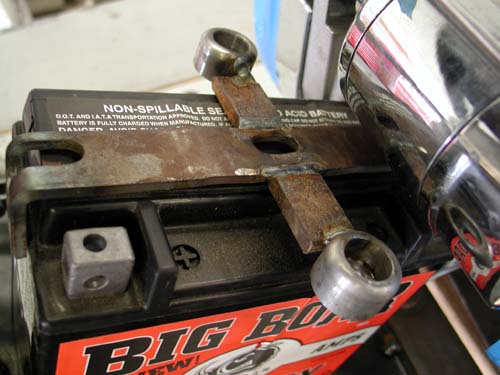
I went to work mounting the battery. It’s humorous how the slightest element of building a bike can become complicated. I wanted the battery to clear all elements, not rub against the transmission or be close to the chain. We needed to be able to remove it, pad it and reach the terminals.

I made thick 1-inch bungs and taped them to 3/8-18 threads for a solid connection, then discovered that with the tall bungs in place I couldn’t remove the battery without removing the transmission first. That wouldn’t do. I removed the tacked bungs, ground the welds away and machined them down to 5/8-inch height. Ultimately, I welded in a block to prevent the battery from slipping forward. With each tacked modification we tested, removed and replaced the battery.
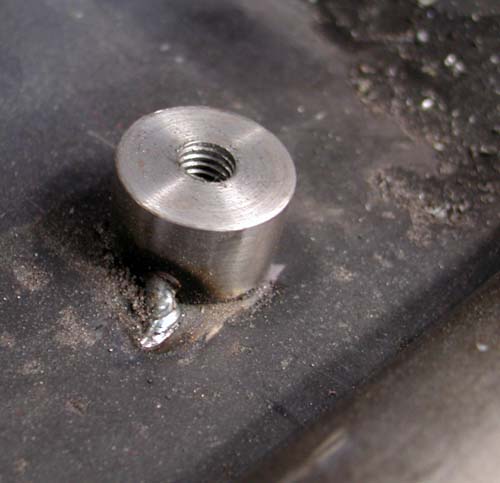
It’s tough to build any bike without all the elements in place. In our case we needed an engine, the BDL primary drive, the Baker transmission and all the pulleys and sprockets in place and linked. The slightest movement from any major element and we could face serious consequences. I used an old engine-shipping, top motormount to make the top battery strap and I’ll need to order the proper length stainless Allens from our fastener sponsor, DMP.

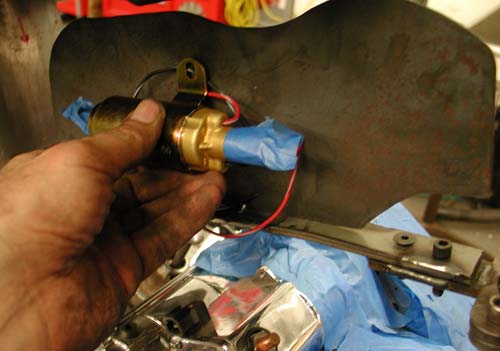
Somewhat confident with the battery mount we worked on the circuit panel above the battery and cut it to clear the spark plug wires, but give us lots of room to install Nitrous solenoids and fuel pumps.
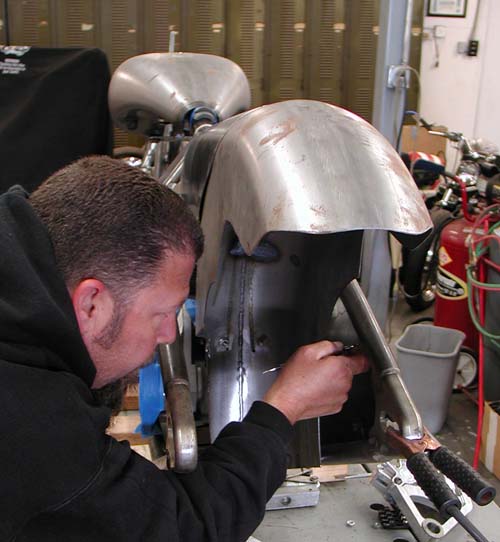
Some element of this masterpiece can’t be handled or roughed out solo. I needed another set of hands to actually attach the side panels and make bungs to hold them in place. Back in 1990 on the Easyriders team the brothers used Zeus fittings to hold the panels in place, the same fittings that hold Harley-Davidson saddlebags in their cradles. For some reason, I just used ¼-20 nuts welded to the backs of 1/8-inch thick brackets I’ve held onto for 20 years. Don’t throw anything away and organize shit, so you can find it. Ya never know.
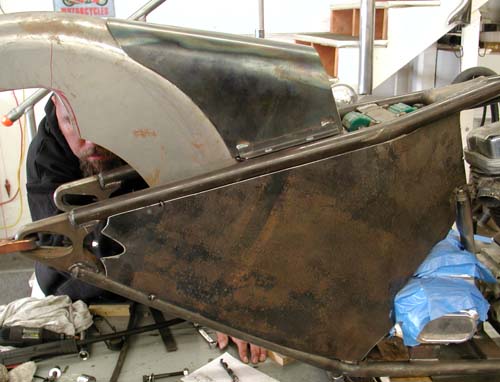
We tacked one panel in place and removed the rear wheel, battery and transmission. Jeremiah wore a leather glove and held the brackets in place while I tacked them. We scored the inside of the bracket fastener, as a guide, to drill panel holes and ground our outside panel tacks away. We removed the plates, welded the brackets, Jeremiah drilled the holes and we tried fitting the panel again.
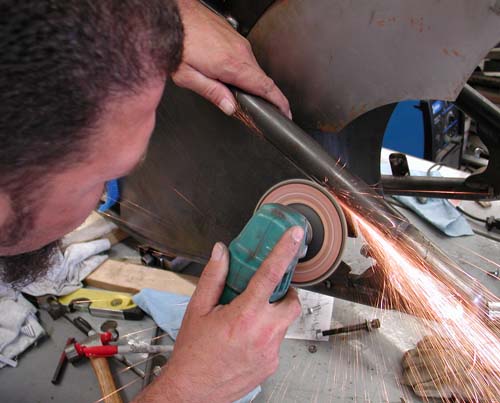
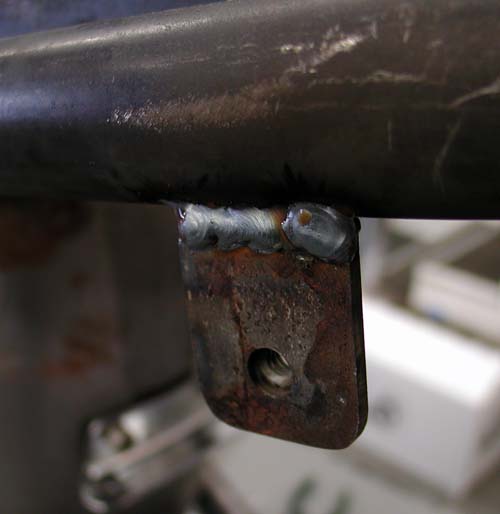
Again we had to think about tubing and wiring routing, and eventually we knocked a couple of tabs off and relocated them.
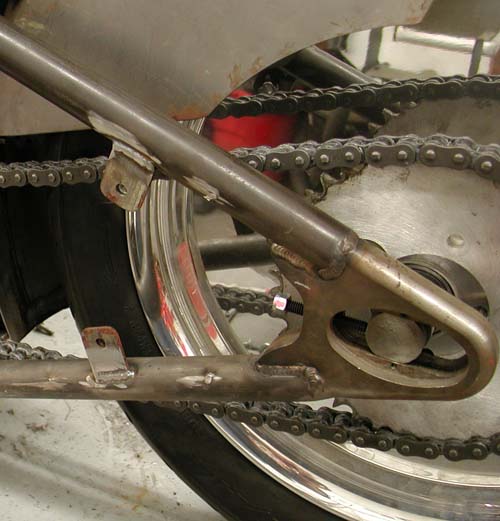
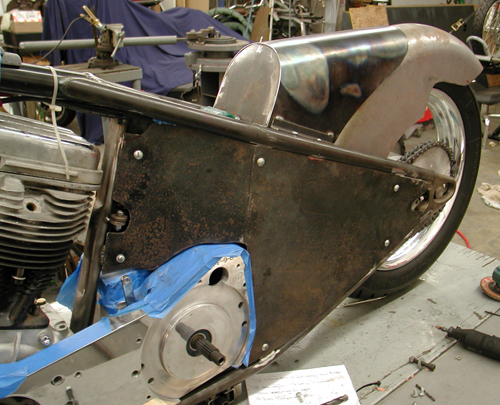
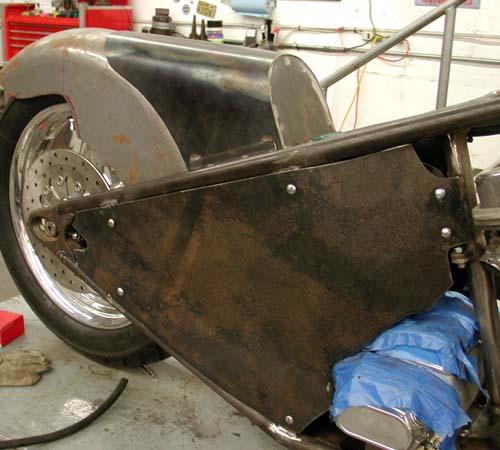


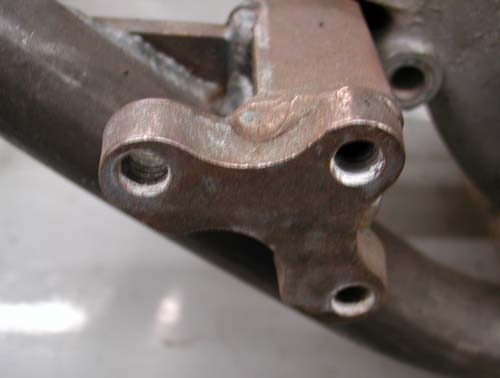
Before I could consider building the oil bag, since we still didn’t have a front end, I needed to create a center-stand that wouldn’t interfere with anything and hold the bike securely. I was using two, 2-by-4s which amount to just over 3 inches in height. We kept wandering around the bike looking for a way to make a stand. One option was the Paughco front peg mounts, which we had no use for. Again, we wanted something strong and secure, without interfering with aerodynamics. I went to work Plasma cutting chunks of flat ¼-inch steel, grinding and drilling them.
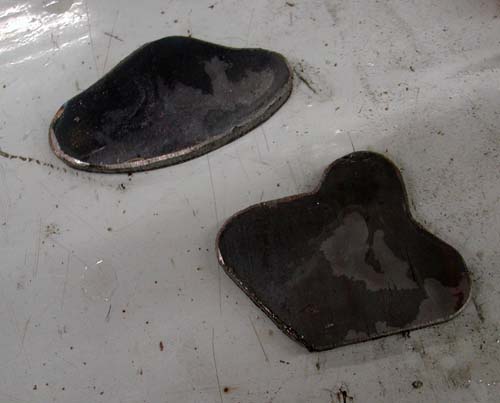
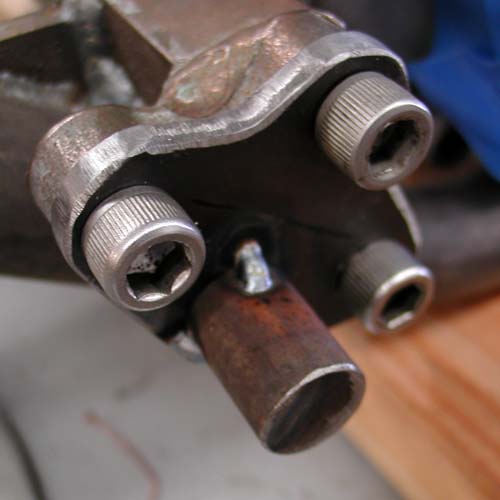
I swear that some days I can indicate the appropriate location for drilling and bore holes all day that line up. Other days I couldn’t drill a hole in the proper location for all the opium in China. This was one of those evenings. Maybe she was on my mind, I don’t know. Then I needed to figure out what height and create a plan. I went back and forth a number of times, cut chunks of solid stock 1 inch long, made a number of measurements and finally tacked the big tits in place taking care to insure that they were aligned, so the stand would be square on the frame. Then I cut thick wall tubing sections a ¼-inch less in depth to avoid jamming against the welds.
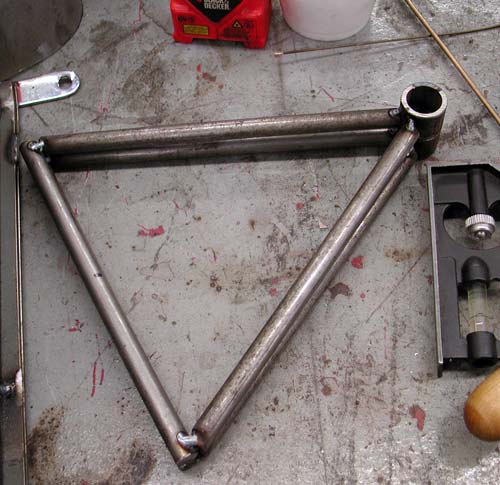
We measured the height of the desired lift time after time and fucked it up a couple of times before we nailed it down. Then we cut lengths of solid 3/8-steel rod and built the platform. All-in-all, it came out cool and holds the front of the frame securely without hindering our oil bag construction or mounting.
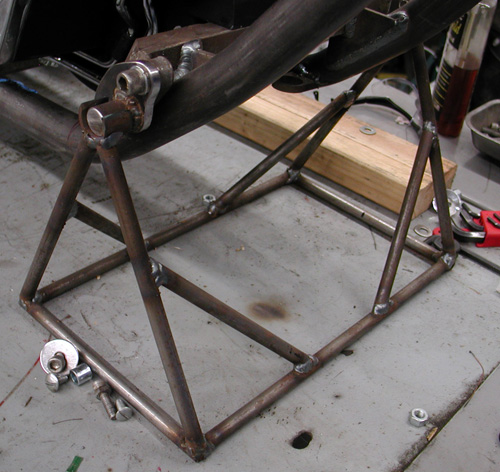
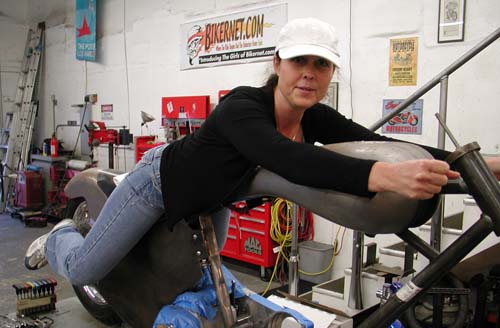
Wait until you see the oil bag under construction, plus we will show you the rider pegs in the next chapter. Every element impacts another aspect and we need to finish the chain guard required by the SCTA rule book.
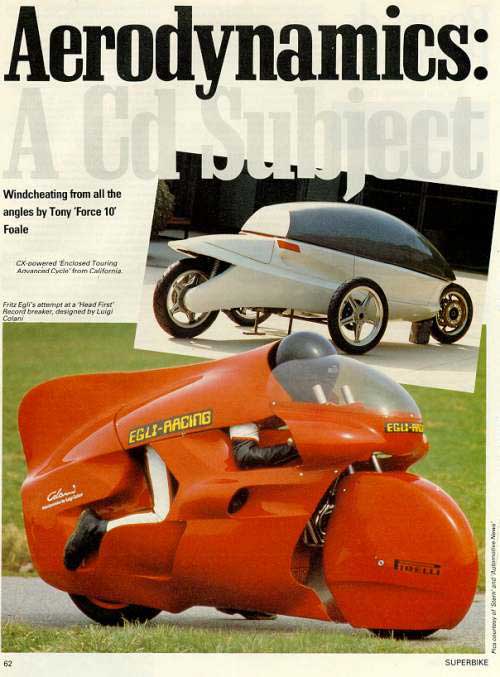
5-Ball Racing Chapter 5
By Bandit |

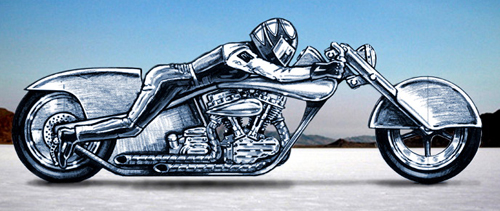
I’m smokin'. This is going to be a scrambled, heavy report, so grab a beer and relax. Just when we thought the Assalt Weapan effort was toast or in serious jeopardy, the gods of Stroker Motors stepped up. First we had a glitch with the frame and Paughco saved our butts. Then Berry Wardlaw called and announced, in somber tones, that he was faced with financial woes, and well, you know, trouble in paradise. I immediately spoke to Brett Smith at S&S and his team was on the case like ants on spilled ice cream. I was smokin' again, except that S&S doesn’t build a Panhead engine, or didn't at the time. We discussed a Shovelhead and a configuration for success at Bonneville with Eric and Scott from their racing department, but many things bugged me. How could I build a secret engine powered bike and write articles about it.
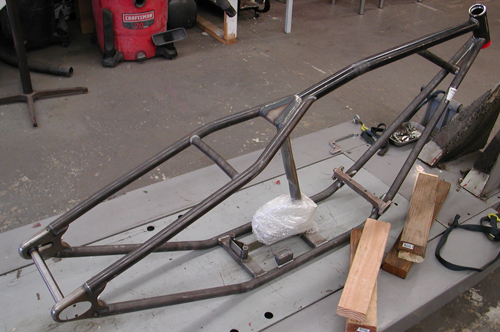
We started with Accurate Engineering, and I hated to switch mid-stream. Plus, this is the World Fastest Panhead effort. What the fuck? I went back to Berry, and he was dedicated to the project. I told him to stand tall, with his right hand in the air and his left on a 120-Outlaw 45 caliber pistol, and swear to the gods of salt that he could deliver. He quivered and answered in the affirmative. Berry is one hard-working brother. He's pulling through the hard times, getting back on track and building the best classic performance engines in the industry. We were rockin' once more. But when would his engine be delivered?
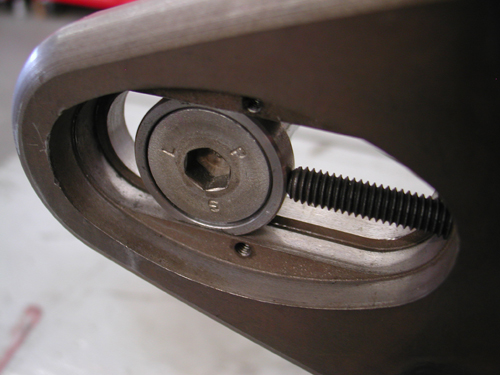
Regarding S&S, I thanked them profusely and offered to build a bike around one of their motors next year and take it from start to finish throughout 2008. Suddenly we were back on track. But that’s not all. As you will see, we’re messing with sheet metal with the help of a local biker, Jeremiah, a talented construction worker with a passel of ex’s who harass him constantly. Rick Krost from U.S. Choppers came over recently and gave me a hand with some of the sheet metal efforts, and suddenly we were missing a plasma cutter and had to muster the cash to buy a new one.
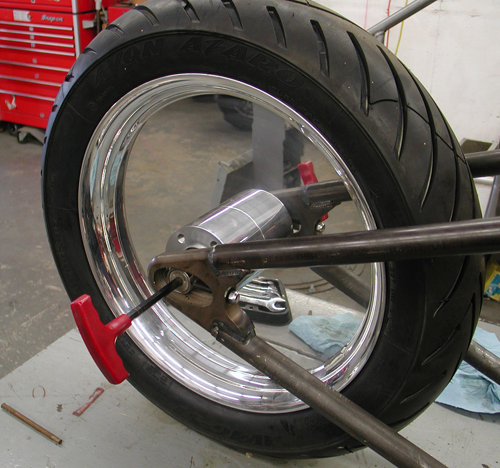
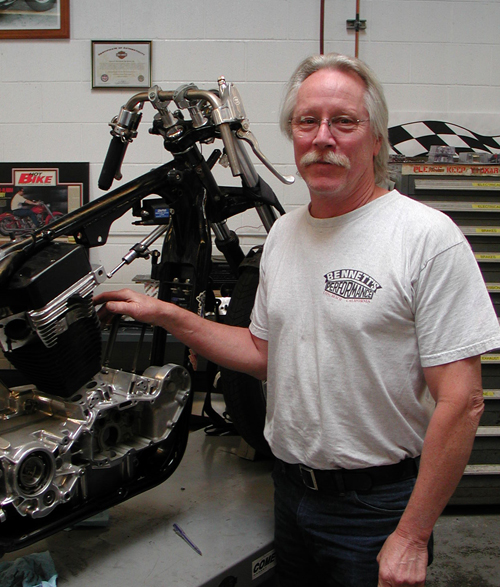
Beyond the shop woes and adjustments, we constantly reach out for information, knowledge and insight into making this the World’s Fastest Panhead. A Bikernet reader, Rick R., recommended that I find the March issue of Hot Rod magazine and read their article on Wind Tunnel testing.
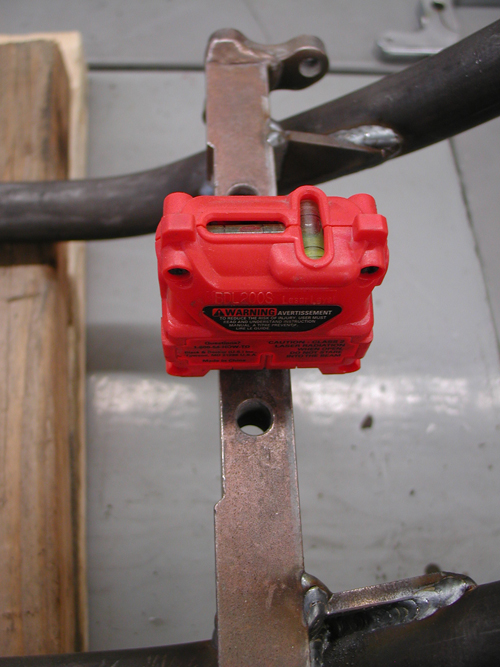
Here’s an excerpt: “… As any bench racer knows, if a car is running at its top speed, then to double that speed would require eight times the horsepower. More practically, to go just 25 percent faster—say, from 125 to a bit over 155 mph—requires double the horsepower. Or you could go faster without adding a single horsepower by making the car sleeker, being more friendly about inviting the air to step out of your way. That means getting familiar with aerodynamics…”
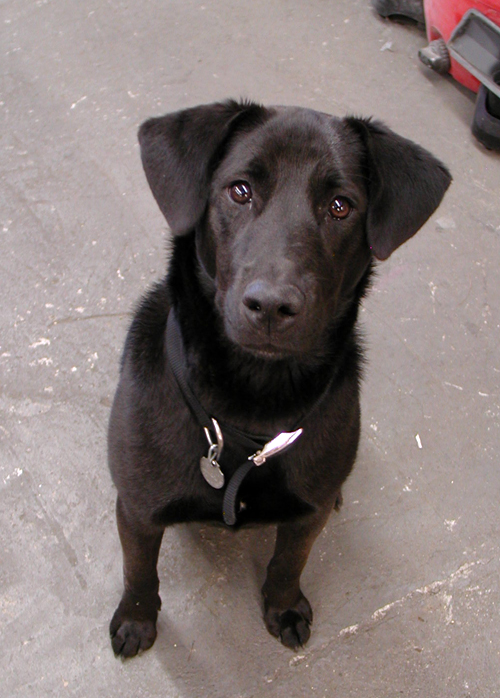
That’s what we were talking about. I remember standing on the salt and someone telling me I had to push my hp up five times to increase my speed, while I looked at a 50-cc, 130-mph streamliner. Something didn’t jive.
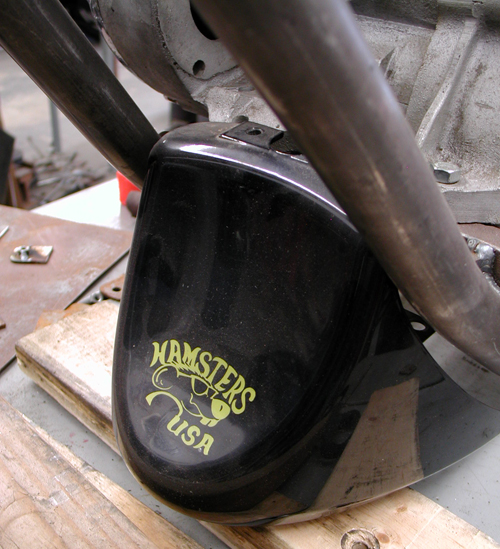
Here are some other tips I absorbed from the article:
“Lower the ride height. Dropping the car front or rear will reduce drag.
Block the grill: Always get air around a car rather that through it. It also reduces lift.
“Add a front air dam: Keeping air out from under the car both reduces drag and neutralizes lift for solid aero gains.”
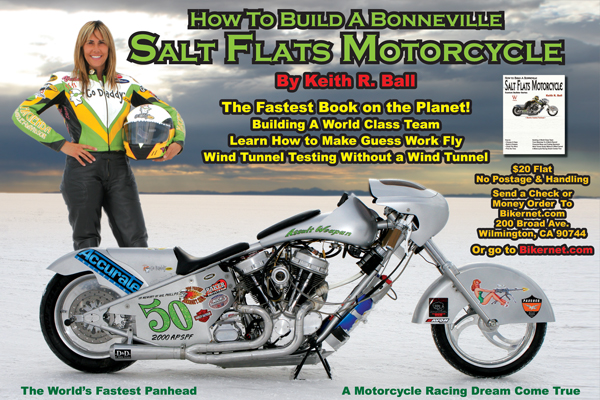

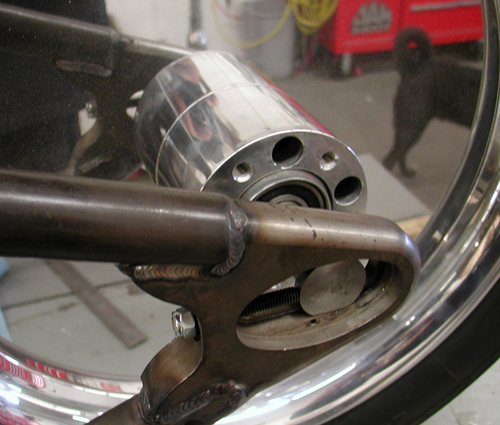
Rick Krost also sent me the following golf ball article, which basically explained how dimpling golfballs reduced drag and allowed them to fly faster and more efficiently. But it also pointed out how the shape of a wing far surpassed the round golf ball. Dimpling is not a factor, but on the other hand waxing a sheet metal surface to a slick baby’s ass smooth finish doesn’t matter at all. Here’s what David Freiburger said in his Hot Rod article: “Contrary to what you may read on your favorite message board, well-waxed, smooth paint is no more aero-dynamic than the worst spray-can, flat-black primer job you can imagine.”
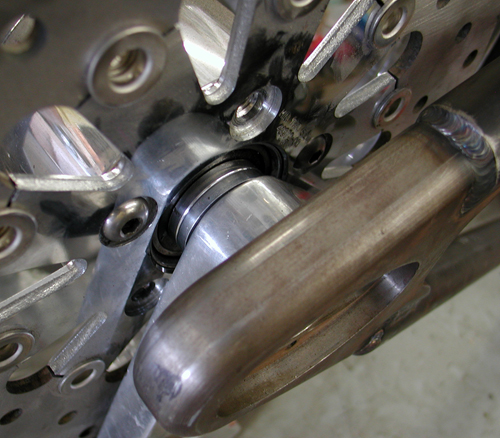
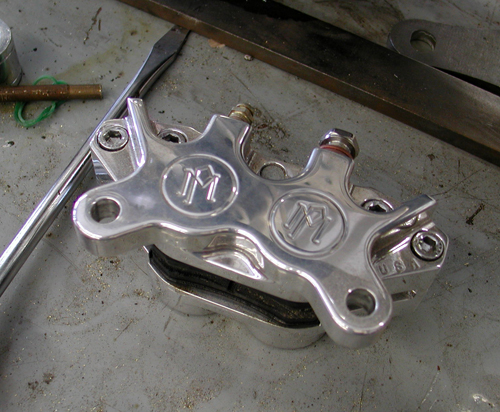
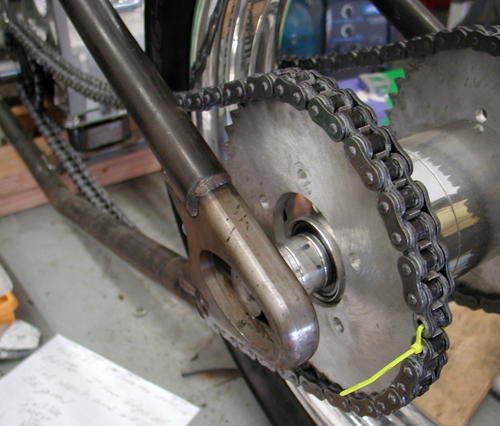
Says Rick, “Here are portions of the dimple article:This was brought forth from my favorite aerospace website. It was authored by Jeff Scott. This helps to explain the aerodynamic effect of dimpling on spheres, or as we know it, 'the golf ball theory.' It's pretty brainy, so the pictures tell the story…. for those of us who don't buy Playboy for the reading content. I believe we should employ a combination of these theories on the Assault Weapon.
You will have to bribe me with El Torito before I spill any more beans…….”
–Rick
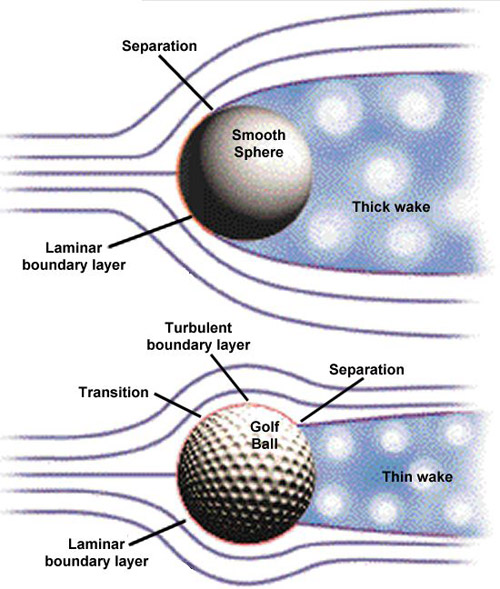
While few among us can deny that golf is one of the least exciting of all spectator sports, we aerospace engineers are fascinated by its aerodynamics! Even the non-golfers of the world are familiar with the shape of a golf ball, like that pictured below, and have probably wondered why its surface is covered with small indentations called dimples.
The dimples of a typical golf ballBefore explaining the purpose of dimples, we first need to understand the aerodynamic properties of a sphere. Let us start by looking at a smooth sphere without any dimples, like a ping-pong ball. If we lived in an ideal world without any friction, the air flowing around a smooth sphere would behave like that shown in the following diagram. In this figure, the angle q represents position along the surface of the sphere. The leading edge of the sphere that first encounters the incoming airflow is at q=0° while the trailing edge is at q=180°. A position of q=90° is the top of the sphere, q=270° is the bottom, and q=360° brings us back around to the leading edge. Note that in this ideal situation, the air flowing around the sphere forms a perfectly symmetrical pattern. The streamline pattern around the front face, from 270° up to 90°, is the same as that around the back face, from 90° down to 270°.
(a) Ideal frictionless flowfield around a sphere and (b) the resulting pressure distributionThe lower half of this figure also displays the pressure distribution around the surface of the sphere, as represented by the non-dimensional pressure coefficient Cp. Positive (+) values of Cp indicate high pressure while negative (-) values indicate low pressure. It is the differences between high-pressure regions and low-pressure regions that create aerodynamic forces on a body, like lift and drag.
However, this ideal flow pattern tells us something very interesting. Notice that the pressure at the front of the sphere, or q=0°, is very high. This high pressure indicates that the incoming air impacting against the front face creates a drag force. Nonetheless, the pressure at the back of the sphere, or q=180°, is also high and identical to that at the front. This high pressure actually creates a thrust, or negative drag, that cancels out the drag on the front of the sphere. In other words, this theoretical situation tells us that there is no drag on a sphere!
Early aerodynamics researchers were quite puzzled by this theoretical result because it contradicted experimental measurements indicating that a sphere does generate drag. The conflict between theory and experiment was one of the great mysteries of the late 19th century that became known as d'Alembert's Paradox, named for famous French mathematician and physicist Jean le Rond d'Alembert (1717-1783) who first discovered the discrepancy.
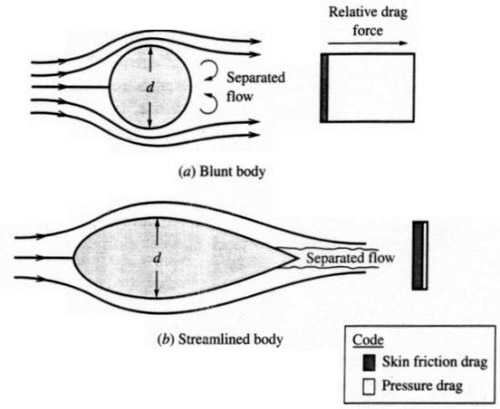
The reason d'Alembert's ideal theory failed to explain the true aerodynamic behavior of a sphere is that he ignored the influence of friction in his calculations. The actual flowfield around a sphere looks much different than his theory predicts because friction causes a phenomenon known as flow separation. We can better understand this effect by studying the following diagram of the actual flow around a smooth sphere. Here we see that the flowfield around the sphere is no longer symmetrical. Whereas the flow around the ideal sphere continued to follow the surface along the entire rear face, the actual flow no longer does so. When the airflow follows along the surface, we say that the flow is attached. The point at which the flow breaks away from the surface is called the separation point, and the flow downstream of this point is referred to as separated. The region of separated flow is dominated by unsteady, recirculating vortices that create a wake…
In the case of a golf ball, increasing the speed is not an option since a golfer can only swing the club so fast, and this velocity is insufficient to exceed the transition Reynolds number. That leaves tripping the boundary layer as the only realistic alternative to reducing the drag on a golf ball. The purpose of the dimples is to do just that–to create a rough surface that promotes an early transition to a turbulent boundary layer. This turbulence helps the flow remain attached to the surface of the ball and reduces the size of the separated wake so as to reduce the drag it generates in flight. When the drag is reduced, the ball flies farther. Some golf ball manufacturers have even started including dimples with sharp corners rather than circular dimples since research indicates that these polygonal shapes reduce drag even more.
Comparison of flow separation and drag on blunt and streamlined shapesThe reason we do not see dimples on other shapes, like wings, is that these particular forms of boundary layer trips only work well on a blunt body like a sphere or a cylinder. The most dominant form of drag on these kinds of shapes is caused by pressure, as we have seen throughout this discussion. More streamlined shapes like the airfoils used on wings are dominated by a different kind of drag called skin friction drag. These streamlined bodies, like that pictured above, have a teardrop shape that creates a much more gradual adverse pressure gradient. This less severe gradient promotes attached flow much further along the body that eliminates flow separation, or at least delays it until very near the trailing edge. The resulting wake is therefore very small and generates very little pressure drag.
However, there do exist other types of devices commonly used on wings that create a similar effect to the dimples used on golf balls. Though these wing devices also create turbulence in order to delay flow separation, the purpose is not to decrease drag but to increase lift. One of the most popular of these devices is the vortex generator.
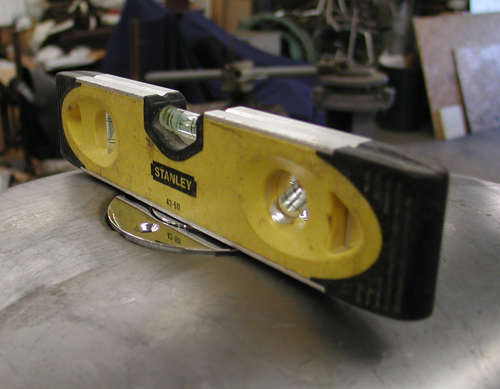
So let’s get to work. I don’t have tools for sheet metal fabrication or the training, so I reached out to Custom Chrome for support and the initial fenders and tank to work with. They stepped up and are now a sponsor.
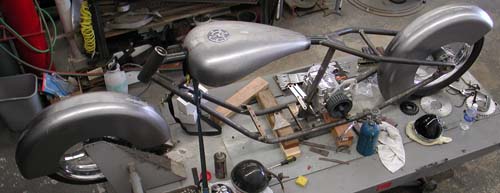
I started by mounting the CCI tank that fit like a dream and contoured to the frame. The tunnel was deep so it set right down on the top tube. I asked our front end maker if he could tell me how far back the tank needed to be mounted to clear his RMD-manufactured girder front end. He started asking questions. He needed the following:
”Let me give you a little more to go on,” Leo said. “Front end fitment for custom bikes is a subject that you should do a article on. To make a front end work from a performance standpoint or from a safe yet perfect stance application is a matter of the front end coming into the picture last. If you ever notice how the bikes built by David Perewitz or Matt Hotch (although completely different ) have that perfect stance yet drive just fine its because they have the front end built based on real dimensions after some parts have been accumulated and mocked up.
“Here is a rough overview of steps for good measurements to help determine front end length and trail. We will deal with this based on a rigid because that's what we are working on. Mount the rear tire assembly in the bike or set the axle height in the frame at the correct height based on the tire diameter (the tire diameter will change based on rim width). Then set the chassis to the desired ride height. At this point,” Leo continued, “you might want to check and see if the axle adjusters are running parallel to the ground.
If not, you should figure approximately where the axle would be, based on chain length and power plant placement. Now that you have these things in place, rake and neck height perpendicular to the ground are truly measurable. As I stated, this is a simple overview but it help with any front-end project.”
A. ground clearance from the bottom of the frame to the ground______________
That's 3 inches.
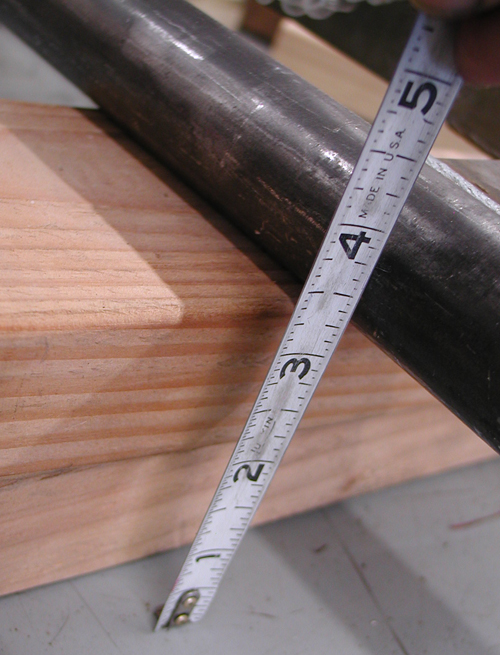
B. From the bottom of the frame to the center of the neck _______________
Directly down from the neck, it's 24 inches.
C. rake_______
34 Degrees as Leo requested.
D. front tire diameter_________
Right now it's 24.5 inches, but if we shave the tires, it will be less, by maybe one-half inch.
E. no brakes on the front____________
Yep, no brake. This bike ain't about stopping.
F. Approximate neck diameter at at the ends____________
That was approximately 2 3/16 inches.
G. picture of the fork stop______________
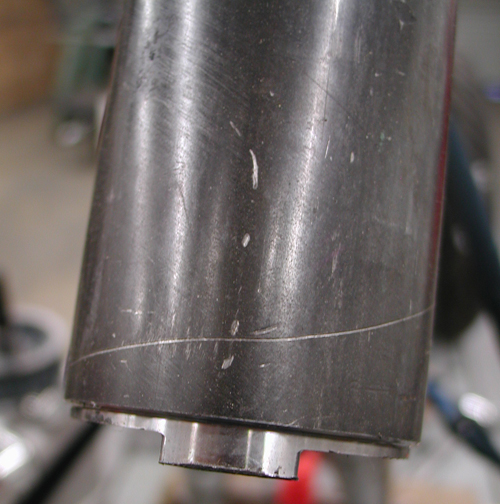
Here ya go:
H. distance over bearings in fork cups ______
No fork cups
If any of this doesn't make sense let me know
Some, but we'll figure it out.–Bandit
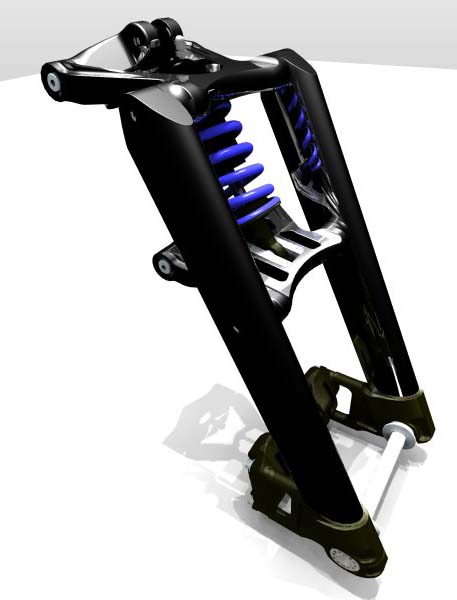


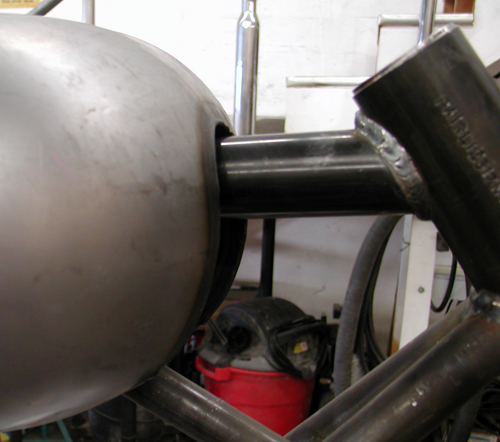
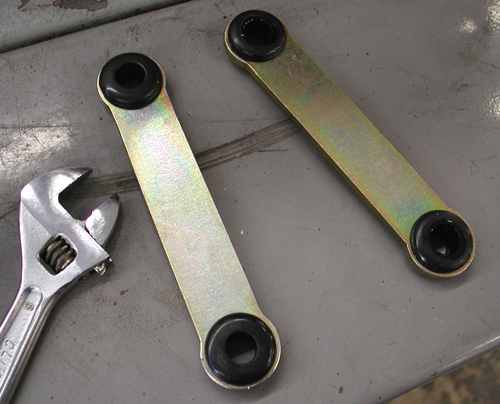

With all the data in hand Leo sent me a sketch and estimated that if the tank was 2 inches behind the neck I was good to go. Unfortunately, I still didn't have a front end. The Custom Chrome 5-gallon unit came with all the mounting tabs, rubber grommets and fasteners. I worked on spacing, centering and it was as if they built the mounting system and tank shape for this bike. She fit right into place. Some serious mods to the tank are forthcoming, but we needed the basics in place, quick.
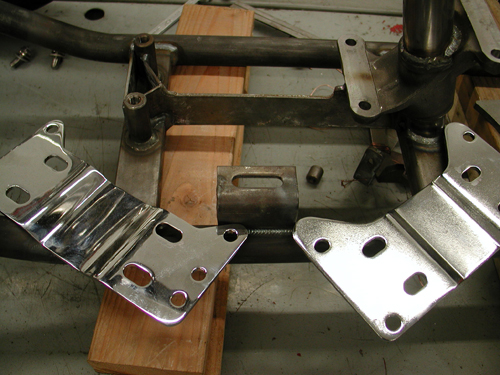
To set the rear fender in place the wheel needed to be centered with a chain and sprocket linked to the Baker transmission. We needed the 1-inch Doherty wheel spacer kit which is a lifesaver, but I ran into a problem. I dug out all the transmission plates I had for Softails and none fit. I called Jason at Paughco.
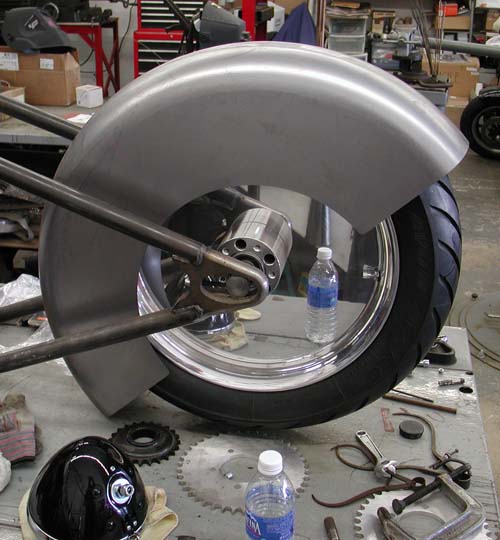
“What are you nuts?” Jason said. “You can’t run a Softail plate.” I ordered the right one and we are working with Paughco on a short tech on what plates fit what. I still don’t get it.
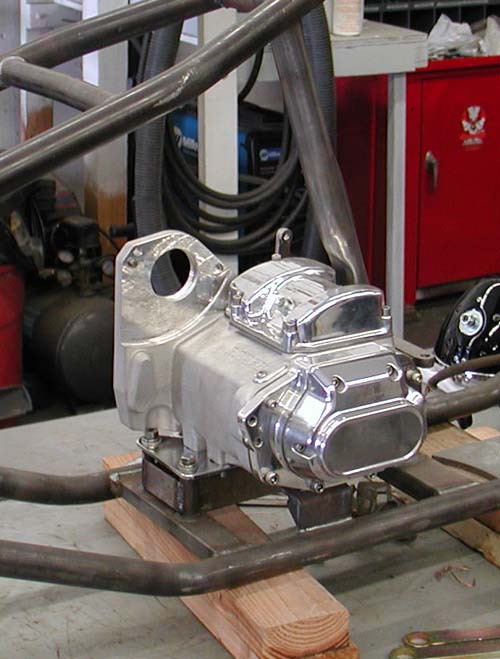
With the proper plate in place, our BDL closed-belt primary arrived and we could bolt up our inner primary and guess about the transmission location. We didn't have an engine, so Rick Krost of U.S. Choppers loaned me a gutted ’48 Pan motor for positioning purposes. I could finally jump in and get to work, although I was squeamish about sheet metal fabrication, but I had no time to lose.
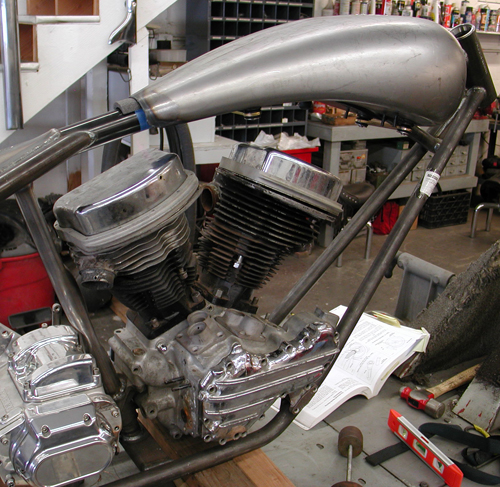
I went to work on positioning the rear fender. With the help of Paughco brackets I built the Nitrous bottle mount and a plate to lock the rear fender in place. Rick came over one afternoon and we burnt through an evening making a plate to house the rear fender and Teflon buffers for the long chain.
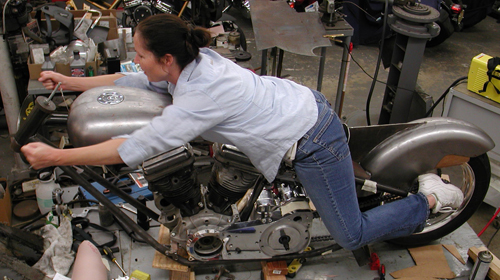
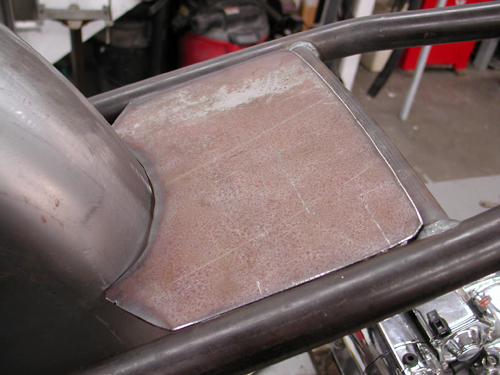


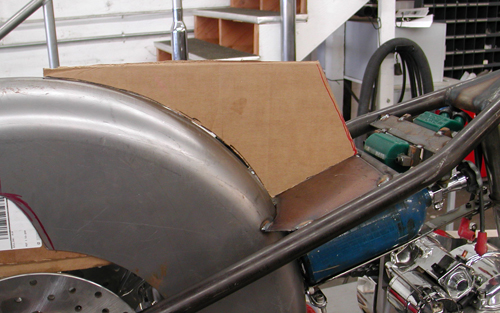
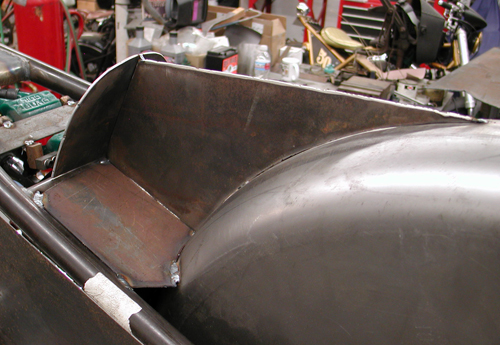
Then I plasma-cut the 1/8-inch chunk of steel to support the rear fender and the back of the seat for Valerie. From time to time we called Nyla out of her office to test the positioning, since she’s a similar size to Valerie. She jumps on the lift between martial arts classes and gets in position.
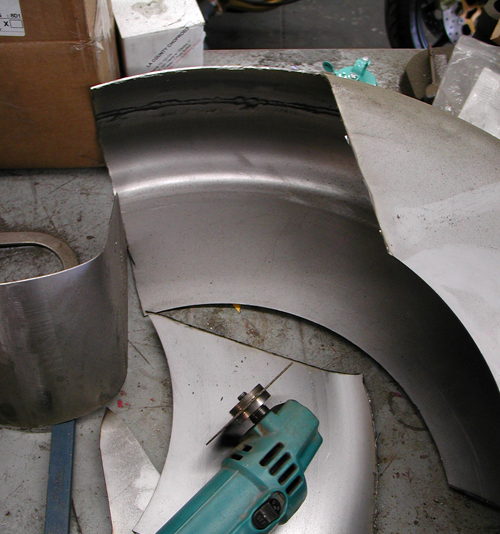
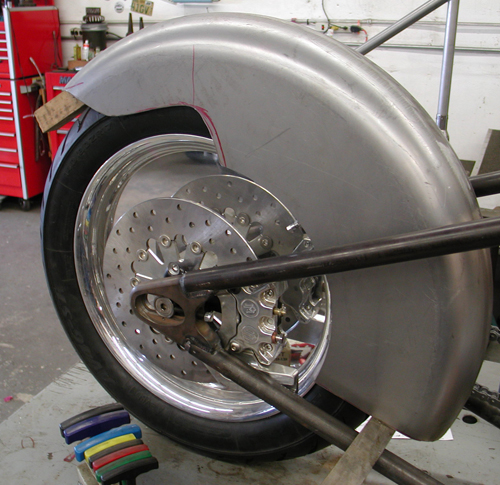
Jeremiah, who has his Shovel at the Bikernet shop for various fabbed parts, has put in a lot of hours working the rear right plate with me, and last night we poured over the arched chunk of 16-gauge steel for the seat backing plate section. This area will also house electric components. We made a tool for bending that plate and still screwed up. It took us a couple of hours to get it close. Wish we had an English wheel. Need more sponsors, but we’re moving forward.
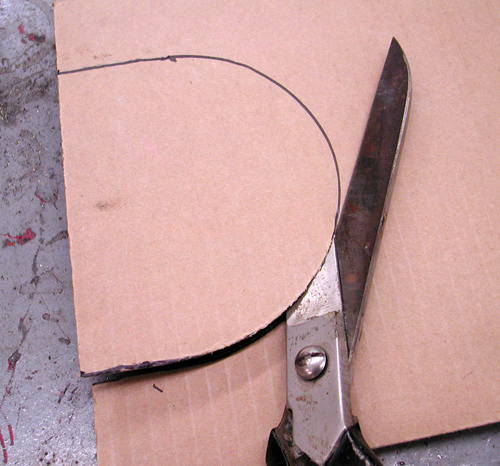
Lot’s of work ahead. Here’s my list:
Neck Bearings installed and measured for Leo—done
Belly Pan—coming up
Kick stand—we still need to figure something out
Rear fender—done
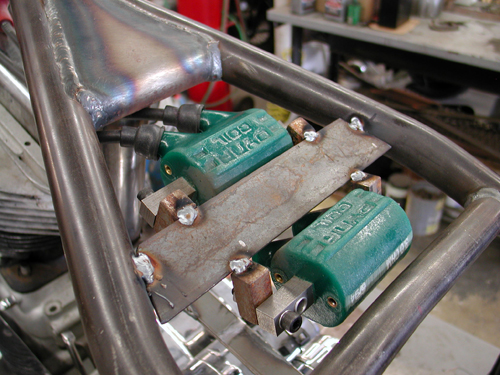
Nitrous mount—done
Fuel pump mount
Nitrous equipment mounts
Pipes
Top motormount
Seat pan
Bars
Tank gauge mount, move gas cap
I gotta knock it off. I can’t handle the pressure. We’ve also been going back and forth with the mysterious Rodan regarding the regs. I’m confused half the time, and natch we’re trying to push the limits in the open bike class. Joel, another Bonneville fan has also been quizzing Rodan as to the rules and his recommendations.
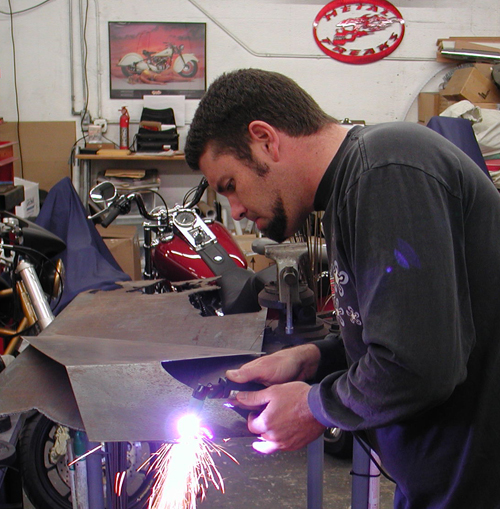
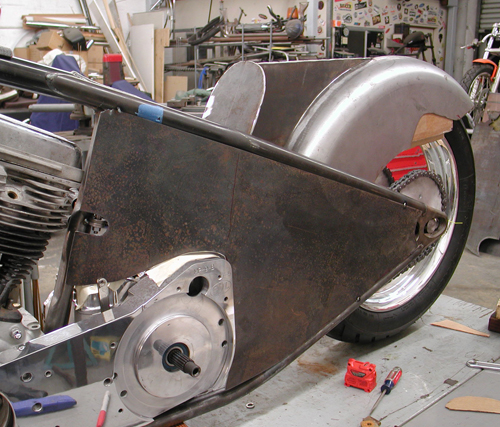
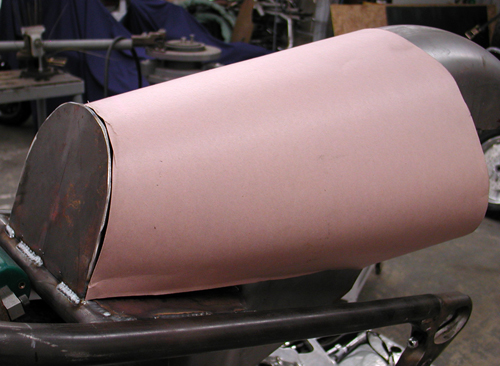


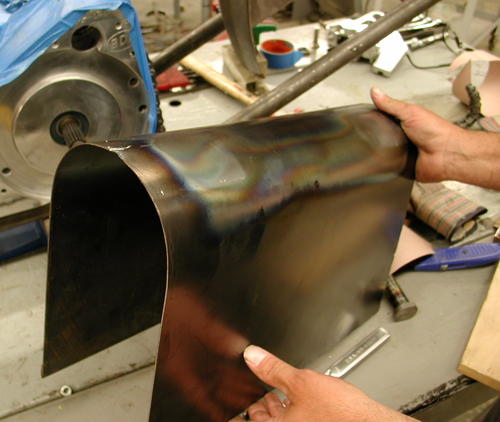
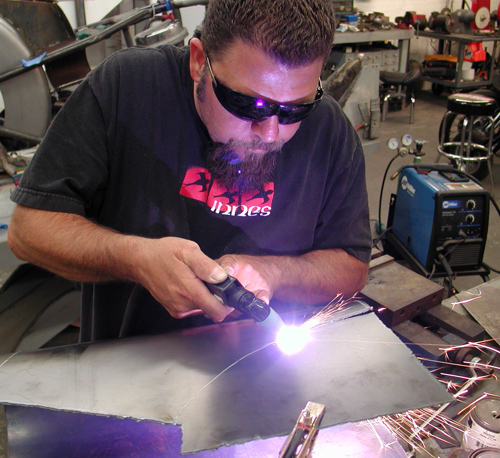
Here are the answers to your questions from Rodan, a SCTA official:
” Rear fender, wheel showing: The minimum rear fender is a flat cover that extends from the seat base of your frame to a point just past the centerline of the rear axle. Like a chopper flat fender. Just has to protect your butt from the tire tread. The max you can have in the open class is a, 'seat or tail section,' kinda like a tt bike seat. It can't extend past the back edge of the rear tire, and it can’t cover the sides of the rear tire or rim to the rear of the centerline of the rear axle. You gotta be able to see the rear half of the rear rim behind a vertical line through the rear axle. Same deal with the number plates, they can't cover up the rear half of the rear wheel.
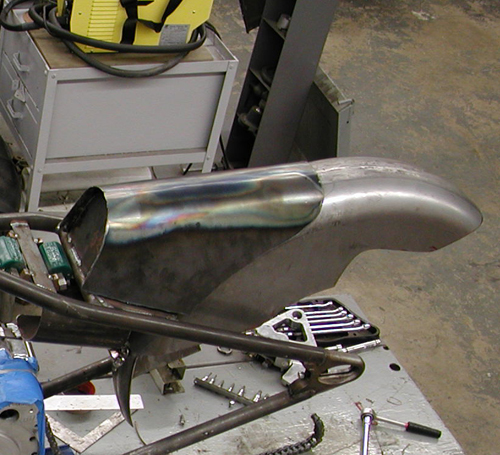
Nitrous bottles up front? Can’t cover 'em up with a slippery cover.
“You can build the instruments into the gas tank as long as they don’t become a wind breaker/fairing for the rider.
“No belly pan, but you might get by with a flat plate that is the bottom of the frame under the engine. No added aerodynamic stuff at all in open class, and no items that direct air around the rider or the motorcycle.
“Think open, hahah. Yes, you can run a headlight, up to 7 inch. [Good idea.]”
–Rodan
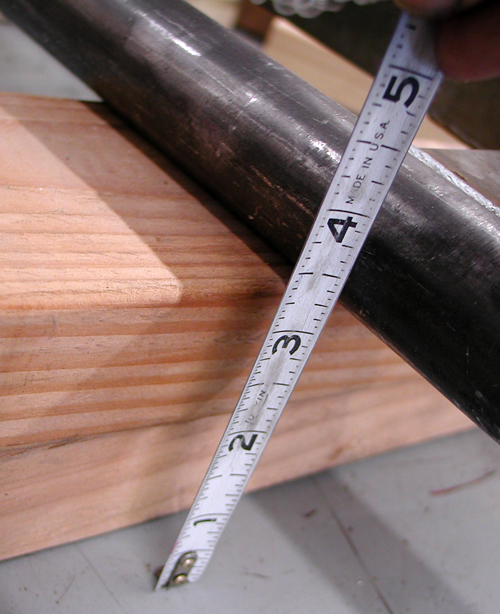
Joel P. asked about down-turned handlebars and Rodan gave him the thumbs up. He also asked about my oil bag under the frame, but the frame is already very low so that’s not a consideration. Rodan gave him the old, “Think Open Bike” mantra again. Finally, he asked about shields around Valerie’s hands, but Rodan scolded and turned him down. “Even fancy gloves can be considered aerodynamic,” Rodan said.
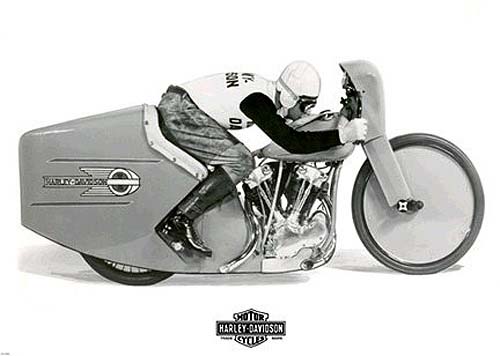
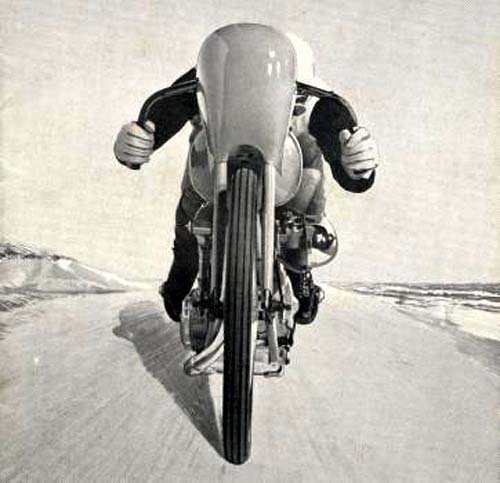
One final thought on aerodynamics from the Hot Rod Magazine website: “Airplanes fly because of lift generated by their wings. Air moves faster over the wing's upper curved surface (as shown over the roof of this car) than the lower flat surface (the air shown under the car). The faster moving air creates a localized low-pressure area. With denser air underneath, lift is generated. Full-bodied production cars are shaped very much like an airfoil so they have natural lift. Good for an airplane, bad for a car.”
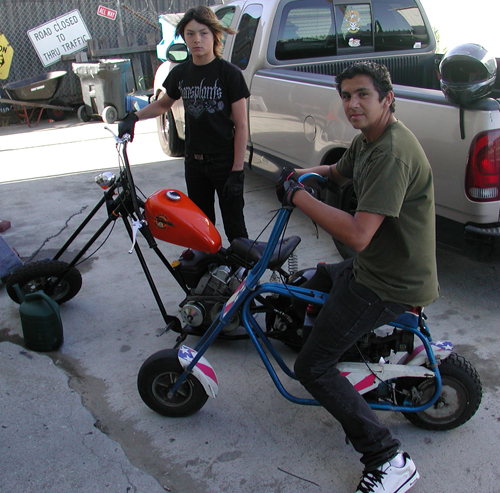
Hang on for the next report. We’re beginning to pick up steam, or nitrous.
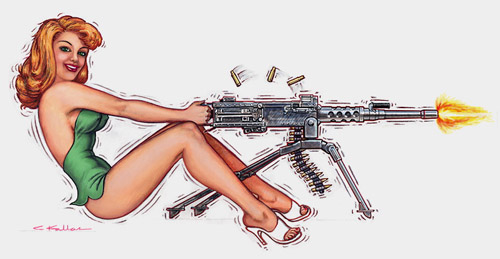

5-Ball Racing Chapter 4
By Bandit |


Hang on, as we ramble into this report after feeling stuck on a Pacific island reef. Our frame team fell apart, and I was forced to pick up the phone, calling my longtime friend, Bob Clark and Ron Paugh from Paughco, around the middle of February. Remember, we wanted to have the frame, wheels and front end completed before the end of 2006. We’re burnin’ daylight quick. Within 24 hours the Paughco frame was a go. We shipped the most recent Chris Kallas illustrations to Carson City, Nevada so the Paughco team had a guide. That made Chris Kallas nervous. “Wait,” he said. “I’m not a frame designer.” We’ll get into that later, but his concerns were noteworthy and we investigated.

While we bit out nails and waited for word from the Paughco Headquarters, Bikernet readers continued to poor in their speed notes.
Bandit, I see you got your wheels for the Pan. You might want to consider a set of ceramic wheel bearings. Check with Dave at World Wide Bearings, 1-800-575-3220. They are used in pro stock drag bikes and many LSR bikes. I have heard of four horsepower gains at the rear wheel because of less parasitic loss through the drivetrain. I installed a set on my bike and didn't do any dyno testing but the bike is much easier to roll around. Might be worth a look. Good luck in September.
We’ve also been told not to run O-Ring chains Eric and his dad, Bob, from Bennett’s Performance on Signal Hill, in Long Beach, California threw-out the following speedy notions (562) 498-1819.
“We run 30 weight oil to minimize drag,” Don said. “We were also told not to run O-ring chains for the same reason and even run 520 chain, to reduce the weight turned by the engine in the drivetrain.”

We also told the Bennetts about our new All American wheels machined by Renegade, and they asked about our tires. “Are you planning on shaving the tires?” Eric asked. Many tires are shaved to alter or enhance their speed category. If a tire is shaved, it moves into the next higher speed category.
”We have a local performance expert who claims an additional 15 mph on shaved wheels,” Bob said and I was sold. “He shaves and balances the wheels.”
We will look into shaving the wheels as we also consider our ground clearance. “Nascars run virtually next to the ground,” Eric pointed out.” We hope to fly out to the University of Austin to work with Dave Rash, the president of D&D on their Bonneville V-Bike. I want to understand how ground clearance may differ between Nascar handling and running a bike on the salt. I recently watched a German speed trial with a 253 mph Bogati Sportscar. At speeds, the car automatically lowers itself to enhance its ground clearance and speed. More to come on that. For now the American/Renegade wheels were fitted and balanced with Azaro Avon W-rated (appropriate to our class) tires mounted by Settle's Motorcycle Shop. Larry Settle guaranteed that they are round…


Another reader spoke up:It sounds like you are planning to run the Pan in altered and run without a fairing, but you might consider a fairing and bodywork to run APS too. A few years ago Scott Guthrie ran several back to back runs on a 200 mph Suzuki Hayabusa with and without the faring and body work at the Maxton mile. They discovered the bodywork was worth 14 mph at Maxton, so it should be worth even more at Bonneville.
Airtech built a sharp body for Wink Eller's 200 mph Bonneville Harley. It's on the Airtech website www.airtech-streamlining.com under the Harley tab. Might be worth a look.
–Rick



Neck Correction–
We received several necks during our initial frame design effort. Leo DiOrio sent the following regarding his offering to make sure Joey Perse received the proper credit:If you do something, article wise about the neck here’s the scoop. Joey Perse, of Perse Performance, made it, and I found it in his special projects room.
I work with Joey on special projects and I am able to move around the facility without an escort (the place is a missile plant for motorcycles).
The idea behind the neck included using bearing cups to take advantage of the industry standard in fork-stops without any extra welding or pinning of the cups to the neck, which in turn means that the neck is still serviceable and reliable without special tools or increased labor, and it opens the end-user up to many triple-tree options without bump style frame stops.
When I told him I needed this for your project since frame maker, U.S. choppers is working on the frame and I'm in Colorado working on the front end, he said for me to take it and let him know what I think.
Don’t state that I built this. It is very important to me that accuracy is applied when talking about innovation.
–Leo DiOrio


Once I received the Assalt Weapan-saving go-ahead from Paughco, I was contacted by Bob Clark, the former managing editor of HOT BIKE and Street Choppers, way back in the ‘70s. He asked me what I needed and I told him a custom frame for our Bonneville effort. He wrote,“Triumph Bonneville?

”No goddamnit,
It's for our Bonneville racing Panhead called the Assalt Weapan,” I returned in reserved tones. That started a flurry of emails with Chris Kallas drawings.
“Tell him I'm running 1-inch axles and a 120-inch Accurate Engineering Panhead engine and a Baker Softail 5-speed transmission. Let me know if you need anything else?”
Fortunately the project was yanked outta Bob’s hands and turned over to JasonPaughco Inc, Frame and Springer Specialist.

”Let me know if you need any engine dimensions, etc?” I asked. Nowadays ordering frames is a comprehensive chore, like a Shovelhead won’t fit in an original rigid frame, or an Evo won’t fit in a Shovel frame. Fortunately this 120-inch Accurate Pan is 3/16 under an Evo height, but some performance engines demand more clearance.
Jason knew what to ask. “Perfect, what about things like tank or oil tank mounts and a rear brakemount? And I'm also assuming you will be running a 5-speed (Softail style transmissioncases).”

”The Gas tank will be completely custom,” I said, “so we don't need any mounts. Standard oil tank mounts will be fine (although I didn’t plan to use them for the oil tank). The rear brake will be Softail type disc brakes, with a 1-inch axle. We are running a Softail style 5-speed Baker transmission and a narrow rear wheel (140/17), no offset.
”Okay that all sounds good exept the 1-inch axle,” Jason told me. “Our ‘regular style’ axle plateswill only accept ¾-inch axles unless you open the plate holes up.

”We can offer you a 1-inch axle only if you want hidden axle plates. I don'tfigure you would want those because of the weight factor.”

Actually weight is not a factor. We want weight especially at the rear to gain traction on the salt. We may fill the bottom rails with shot for more weight and I plan to build the oil bag under the frame.


Chris Kallas, our esteemed illustrator, was concerned about wheel travel on the girder and possibly the tire hitting the neck area. I asked Leo DiOro, the girder designer, to double check that aspect. I also reached out to Jason. “We can always make the downtubes longer,” Jason said.
Let me know your thoughts,” I said to the god of speed. “ The front tire is 25 inches in diameter.”
Rightly so, Chris didn't want us to receive a frame then be forced to modify it.

Here’s what Leo wrote to Jason: My name is Leo DiOrio, I am writing you because, I am building the girder for the salt flats Panhead belonging to that bastard, Bandit, the emperor of 5-Ball Racing. Don’t tell him I wrote you.
Chris Kallas would like to go over the numbers with me one more time just to make sure.
I going to build a math model based on the numbers, we are trying to achieve dimension wise, then when we see the real thing.
A: when the bike is level how much ground clearance does it have?
B: what is the neck height from the ground to the center of the neck?
C: What is the distance over the bearings?
D: Are you going to use the neck I have provided, if so then I can answer C?
E: What is the rake on the neck. I think we are trying to achieve 34 degrees. Is that correct?
I have the tire Diameter. When I get this. I will build a couple of stick models to show the 5-Ball Racing boss the results, and we can go from there. I think were fine but it's been awhile and it’s best to make sure.
–Leo DiOrio
303 438 8991

Chris Kallas had additional concerns and wanted to factor them into the drawings:If you come up with a length for your fork and give me some dimensions, I can rework the drawing to make it work. We had the neck at 34 degrees. I'm also thinking we should raise the frame to 4-inch ground clearance to be safe. Any thoughts on that?
–Chris Kallas

While the questions flew through Internet lines, the crew at Paughco built the frame with 40 years of confidence. They had no way of knowing the actual ground clearance without the wheels, and they don’t work with those parameters. They built smooth custom frames for four decades and have their distinct process nailed to the concrete. It would be up to us to work out the rest.

I had a growing question, and I put it in Rick Krost’s lap. He’s the president of U.S. Choppers and informed me of the golfball speed and distance theory. At one time golf balls were smooth until someone tested the dimpled ball. It eclipsed the smoother version.“If you have any time, could you research the golf ball aerodynamics element,” I asked. Should we dimple our sheet metal or just coat it with wrinkle paint? If you find any studies or papers, we will implement the findings.”
We discovered that it was more than just finish to eliminate drag. We also discovered that dimpled balls have less drag, but the shape of a wing has even more drag reduction than dimpled balls. A teardrop is the most aerodynamic shape of all. Ah ha.


Once I received the Assalt Weapan-saving go-ahead from Paughco, I was contacted by Bob Clark, the former managing editor of HOT BIKE and Street Choppers, way back in the ‘70s. He asked me what I needed and I told him a custom frame for our Bonneville effort. He wrote,“Triumph Bonneville?

”No goddamnit,
It's for our Bonneville racing Panhead called the Assalt Weapan,” I returned in reserved tones. That started a flurry of emails with Chris Kallas drawings.
“Tell him I'm running 1-inch axles and a 120-inch Accurate Engineering Panhead engine and a Baker Softail 5-speed transmission. Let me know if you need anything else?”
Fortunately the project was yanked outta Bob’s hands and turned over to JasonPaughco Inc, Frame and Springer Specialist.

”Let me know if you need any engine dimensions, etc?” I asked. Nowadays ordering frames is a comprehensive chore, like a Shovelhead won’t fit in an original rigid frame, or an Evo won’t fit in a Shovel frame. Fortunately this 120-inch Accurate Pan is 3/16 under an Evo height, but some performance engines demand more clearance.
Jason knew what to ask. “Perfect, what about things like tank or oil tank mounts and a rear brakemount? And I'm also assuming you will be running a 5-speed (Softail style transmissioncases).”

”The Gas tank will be completely custom,” I said, “so we don't need any mounts. Standard oil tank mounts will be fine (although I didn’t plan to use them for the oil tank). The rear brake will be Softail type disc brakes, with a 1-inch axle. We are running a Softail style 5-speed Baker transmission and a narrow rear wheel (140/17), no offset.
”Okay that all sounds good exept the 1-inch axle,” Jason told me. “Our ‘regular style’ axle plateswill only accept ¾-inch axles unless you open the plate holes up.

”We can offer you a 1-inch axle only if you want hidden axle plates. I don'tfigure you would want those because of the weight factor.”

Actually weight is not a factor. We want weight especially at the rear to gain traction on the salt. We may fill the bottom rails with shot for more weight and I plan to build the oil bag under the frame.


Chris Kallas, our esteemed illustrator, was concerned about wheel travel on the girder and possibly the tire hitting the neck area. I asked Leo DiOro, the girder designer, to double check that aspect. I also reached out to Jason. “We can always make the downtubes longer,” Jason said.
Let me know your thoughts,” I said to the god of speed. “ The front tire is 25 inches in diameter.”
Rightly so, Chris didn't want us to receive a frame then be forced to modify it.

Here’s what Leo wrote to Jason: My name is Leo DiOrio, I am writing you because, I am building the girder for the salt flats Panhead belonging to that bastard, Bandit, the emperor of 5-Ball Racing. Don’t tell him I wrote you.
Chris Kallas would like to go over the numbers with me one more time just to make sure.
I going to build a math model based on the numbers, we are trying to achieve dimension wise, then when we see the real thing.
A: when the bike is level how much ground clearance does it have?
B: what is the neck height from the ground to the center of the neck?
C: What is the distance over the bearings?
D: Are you going to use the neck I have provided, if so then I can answer C?
E: What is the rake on the neck. I think we are trying to achieve 34 degrees. Is that correct?
I have the tire Diameter. When I get this. I will build a couple of stick models to show the 5-Ball Racing boss the results, and we can go from there. I think were fine but it's been awhile and it’s best to make sure.
–Leo DiOrio
303 438 8991

Chris Kallas had additional concerns and wanted to factor them into the drawings:If you come up with a length for your fork and give me some dimensions, I can rework the drawing to make it work. We had the neck at 34 degrees. I'm also thinking we should raise the frame to 4-inch ground clearance to be safe. Any thoughts on that?
–Chris Kallas

While the questions flew through Internet lines, the crew at Paughco built the frame with 40 years of confidence. They had no way of knowing the actual ground clearance without the wheels, and they don’t work with those parameters. They built smooth custom frames for four decades and have their distinct process nailed to the concrete. It would be up to us to work out the rest.

I had a growing question and I put it in Rick Krost’s lap. He’s the president of U.S. Choppers and informed me of the golfball speed and distance theory. At one time golf balls were smooth until someone tested the dimpled ball. It eclipsed the smoother version.“If you have any time, could you research the golf ball aerodynamics element,” I asked. Should we dimple our sheet metal or just coat it with wrinkle paint? If you find any studies or papers, we will implement the findings.”
We discovered that it was more than just finish to eliminate drag. We also discovered that dimpled balls have less drag, but the shape of a wing has even more drag reduction than dimpled balls. A teardrop is the most aerodynamic shape of all. Ah ha.


Bonne Belle Update
While the frame was under construction and Berry Wardlaw studied the World’s Fastest Panhead engine configuration, another 5-Ball effort made progress. The 1940 WLD flathead, at Departure Bike Works in Richmond, Virginia witnessed true progress. Hidden in an Ozark Cave, until recently, were etched stones containing flathead speed secrets. Lee Clemens, the Boss of Departure, knows all who know anything about engines and performance. He had a distant drawn-and- quartered connection and came in contact with these highly secret tablets. The mystery continues

I’ll try to innumerate several of the 45 cubic-inch, side valve performance suggestions. Originally we discussed dual front cylinders for dual carbs and better air flow. There’s a problem with that recipe. First we found that K-Model top ends flow even better than dual carbs. Plus trying to find and possibly breaking up two sets of rare WLDR top ends wasn’t a friendly formula and a tough menu to follow.

That’s not all. Jim Lienweber would be forced to grind some very exotic cams for the dual-carb job, whereas a clean set of WLDR cams fit the golden formula for 45 speed.


There’s a baffle in one of the cylinders to create just the right mixture of oil to enter the cylinder under the piston of a stock 45. In the above case, part of our speed mixture, called for baffle removal to allow the piston to scream up and down the cylinder unhampered. Backing up that modification called for machining the breather gear in the cam case to create the ideal vacuum, let the motor breathe and the air evacuate. This also forced Ross pistons to deliver three piece oil rings over the stock one piece jobs.

In order to mount the K-Model top end, the precursor to the Sportster, a stud needed to be moved. Flatheads have four square studs, like at the corners of a square box. Sportsters and K-models come with one stud, slightly out of wack. It forced Lee to machine aluminum studs, run them into one cylinder mounting, case stud hole, slice it off and re-face the surface.
That’s not all. The cylinders needed to be measured from the crankpin up so that the head lands on the cylinders were perfectly square and the same between the cylinders for exact compression.

That’s not all. Lee needed to check the face of the heads and make them absolutely square with the top of the cylinders.

Lee discovered that there was a difference in the thickness of the heads from the valve side to the combustion side. He made a fixture to hold the heads perfectly square (upside down) so he could machine the correction into the mating surface between the aluminum heads and the iron cylinder head gasket surface. It took him a while to discover all headbolt surfaces are not created equal. He was forced to study the distances from the head gasket area to the headbolt washer landing to determine how to create the ideal fixture. He burned through another day in the shop trying to create the Worlds Fastest 45 Flathead.

That’s not all. Skeeter Todd dropped into Departure Bike Works to discuss all that’s performance in the kingdom of Harleys and the conversation shifted to the Bonne Belle. “What transmission are you going to use,” Skeeter said. Skeeter is like a monk from the flathead piston tribe in the Catskill Mountains. When he asks a question—he knows the answer.
“The stock 1940 three-speed with a tall rear sprocket,” Lee timidly muttered, knowing he was about to have his ass handed to him.
“With a stock 3-speed you will fall off the cam in third gear, and struggle through miles trying to retrieve the needed rpms to reached the peak power curve,” Skeeter pointed out graciously. The stock transmission was out. Lee has a connection for wrecked bikes through insurance companies and volunteered to cut a 5-speed transmission off a late-model Sportster and ship it to the other coast. “One problem,” he said. We need to seal up the case and develop a means to fill it with oil.”
Seems S&S makes a trap door with an oil fill hole and sealed bearings. Then it’s up to me to form the welded transmission case and mount it in the exact location from the engine drive sprocket as a Sportster, so we can run a Sportster designed belt system. We will also run the late model Sportster clutch. Another beneficial project.

I immediately called Greg Friend, the former Street Chopper editor, who now is the West Coast Editor of Barnett’s Magazine. He cut a Sportster transmission free from the case to build a split Sportster custom. “Ah, I sold the transmission at a swap meet,” Greg said. “I’m using a Baker big twin transmission.”
I couldn’t believe my ears. See the image above.



Pin-Up Progress Report

Recently at a secret Bikernet Headquarters Meeting we dug out Vargas books and 1940s pin-up calendars from the Bob T. collection. We discussed every detail of a woman’s body, all in an effort to perfect the Assalt Weapan nose art. Like so many of our projects, it had specific guidelines. We needed to determine where the girl would pose, on what fender, tank, etc.

We decided on the front fender, so it called for a specific position. “What about her straddling a gattling gun?” Wrench suggested.
The more we looked, the more that position worked. Chris went to work.

The girl was too long and small on the fender in this case and we decided to machine the barrel down. At the same time we discussed attitude, the wind, her hair and action.

With each rendition she transcended the last version and we weren't done yet. Watch as she outwits the artist. Next chapter we'll bring the Bonne Belle transmission home and parts will arrive from Ted Tine to finish the 45 headwork.

The Paughco Frame will make muster at the Headquarters soon, and we’ll scramble to test the wheels and front end geometry against Paughco frame realities. Then we’ll match the womanly curves of Valerie Thompson to the style and grace of our steel components and get to work on the sheet metal. Hang on.


Chop N Grind Surfaces
By Bandit |


It’s that time of the year again; race season is about to start! With much success at BUB`S International Motorcycle Speed Trails at Bonneville Salt Flats, the Chop N Grind Crew will be racing again at El Mirage and Bubs Speed Trails.
We now hold the AMA National Land Speed Record for the Modified Pushrod Gas with a 1650cc at 148.307 mph.using a Harley Davidson Evolution/Twin Cam 100 inch Motor.
Thanks to all our sponsors last year the race was a huge success.
We are now acquiring sponsorship for the Bubs Speed Trails and go for multiple land speed records.
Our crew consists of 5 members:
Larry Petrie– Pilot of the racer, with years of experience racing and motor building. Dealership Harley Davidson mechanic. USMC Gulf war veteran.
Bob Tronolone – USMC Vietnam Era veteran. Public relations with all sponsors. Former Crew member of the Easyriders-Jammer streamliner designed by Bob George. (the streamliner was the world fastest motorcycle for fifteen years piloted by Dave Campos.)
“OC” Danny McPherson – Vietnam Era Navy veteran .Pit crew chief, mechanic andfabricator. With over 40 years riding experience.
Rob Tronolone JR. – K-9 Officer. Team photographer and all around mechanic, Journalist and chase truck driver.
Steve Thurston – Army Veteran. Mechanic, parts, pit area, back up driver.

One of our sponsors, Nick Roberts of AMSOIL ,will be supplying lubricates for the race bike and will be riding out from Kentucky to join up with us and give a helping hand. Nick will also be racing his bike in the “Race What You Brung” Class.
Jim Leineweber ,of Leineweber Enterprises, is grinding our cams. Jim is a local in our town. He has been grinding and racing since the 1950`s.
Big Mike, of BMC Choppers, will be on board again and is talking about joining us also.
AVON TYRES has committed today, the tires they supplied last were great.
Our crew and sponsors have a great camaraderie that brings us all together to form the team we have.
Bubs Speed Trails is entering its 4th year this September. It’s an all motorcycle event and old school camaraderie. It’s a passion which no one ever forgets.
We developed a large following of racers and spectators, due to our helpful nature. One of the Bubs officials commented on our pit area being organized and clean and thanking us for helping other racers in need. That was a great comment for us.
We are again looking for sponsors, we will promote your product to the racers on the Salt.The race bike will have full exposure of your product, as well as the crew, pit area with banners, chase truck, and trailer. We ,as a team, look forward working with all our sponsors and making history.
A DVD and Press time will be provided at the end of the races. Our T-shirts, featuring our world famous logo, will be ready for sale in about a month. We sold out before we got to Bonneville last year, so act fast.
All sponsors are invited to join us on the Salt in September. This is an experience you will never forget, and yes, we will all be riding out from So Cal again. Last years ride to the Salt Flats was outstanding, so anyone out there who wants to ride out contact us. We can help line up the rooms. Seven months left. So plan on it now!
Thanks for your time and support
Chop N Grind Racing
Bob Tronolone

Assalt Weapan Bonneville 2007 Effort, Chapter 3
By Bandit |


In this chapter we’re taking all the plans, boiling them in oil and spinning them into action—no bullshit. The frame is underway, as you will witness. The wheels are in hand. The transmission was delivered and the Avon Tyres were shipped today.
The notions and input keep flying my way via e-mail and phone calls, but let’s jump right into the middle of the action, beginning with Rick Krost, who is building our Assalt Weapan frame, at U.S. Choppers:

Seriously, I need to get engine dimensions first. Also would like to know centerline numbers from engine shaft to tranny shaft if you have a primary and clutch pack picked out. If it's all production stuff–that’s fine, but realize that some guys produce their primary with the wrong measurements making the belt too tight, which in turn makes for a shitty clutch and near impossible starts……so just because they have a big name still doesn't mean their products work!!
If we have a primary in hand, I can use it when building the frame for real numbers, so we don't experience binding in the drive-train (we use BDL and have never had a problem). Remember, if Berry, Accurate Engineering, does his job perfectly, as I assume he will, then we can lose all of his talent through the primary/clutch set-up. If you have those numbers, I can start getting my drawings together and start frame building.
Also front and rear tires will vary from 23.5 to 28 inches depending on the side-wall heights and rim sizes – 23.5 for 16-inch rims to 28-inch for 21-inch rims…. plus or minus the side-wall and tread differences….. this is a 5-inch disparity that we must make provisions for! I believe Chris Kallas (official 5-Ball racing illustrator) has both wheels at 26 inches, if I am reading the drawing correctly. This would most likely mean a 18-inch rim in back and front with 4 tall side-walls and tread. If we are at 26 inches then the axle center would be 13 inches off of the ground as Chris illustrates.
To make our measurements linear, then of course, the same would apply for the front tire measurements to make the frame level to the ground as the drawing illustrates……(so I believe we should have our tires and wheels first, in order to make measurements for the frame and front end). This would assure we don't run into any problems with regards to having 3 inches of ground clearance from front to rear and we can make accurate assumptions for front end length and trail calculations.
Get this, if you make a perfect structure and set it on an imperfect surface, all of those measurements were for not. Thus like a tailor fitting a suit, we must have a starting point.
My thought is that the starting point should be the axle heights and if we are to nail down those, then we need an accurate measurement of the entire front and rear wheel diameters with the correct Z rated Avon tires mounted and aired up to real air pressures……..
Just a thought, but keep in mind, I'm just a simpleton with a wheel cage that moves about 3 rpms…… so take it for what it's worth.
Also we need to dial in that trail measurement better than “zero” as Chris stated earlier. That would really make me nervous!! I know Leo is our man for that, as he has a lot of potential with the Girder style set-up and it's infinite adjustability. However, I feel like he can do his job better and easier if he has a neck height from me and some “real” axle references as stated before. He can then figure his leg length, calculate for trail/rake and any “sag” on the front end.
Getting really excited about this project- lets get these numbers nailed down and get rocking!
–Rick
U.S. Choppers
2039 S. Lyon St
Santa Ana, CA 92705
714-546-4699
Appointments Only Please

After we received Rick’s e-mail we informed him that we generally use only BDL primary drives and never had a problem with their configurations for Softails or FXRS. We researched our wheel diameters for Chris Kallas and Rick through Avon Tyres. Our wheels with tires mounted should be 24.6 front and 25.8 in the rear.
We now have the All American Wheels cut by Renegade in hand and the Tires are on their way to us. I will have them mounted and deliverd to U.S. Choppers A.S.A.P.

NICK ROBERTS, 5-BALL SPONSOR SPEAKS UP FOR NICK’S PERFORMANCE AND AMSOIL OILS–Great update…I like where you're going with this and I only have a couple of thoughts that I'd like to toss in.
First a question…why is a headlight included in the concept drawings? Is there a requirement that you have a headlight? I would think this area would respond to a more aerodynamic form such as a cover over the steering head and trees and may eliminate a lot of potential turbulence and drag. When I look at the concept drawings my other thought regarding aerodynamics is that the exposed engine is going to cause all sorts of turbulence.We must run an open front end and can drop the headlight in our class, but we need to push the air out around the front of the bike. Unfortunately V-Rod headlights don’t cut it—only allowed on V-Rods. Regarding the open engine we hope to use the pipes and air cleaner to guide the air. Plus, we need some air through the engine for cooling on the hot salt.
Secondly….Thinking back to the Trials it seems like almost all the bikes with fairings, (streamlining), covered their engines. I appreciate the aesthetics of the exposed Panhead engine but I wonder if it wouldn't make more sense to design a fairing around the engine to channel the air needed for cooling while smoothing the airflow around the bike and Valerie. Just thought I'd throw that out for you to consider while you are still in the design phase of the project.
We are running in the open bike class. No fairing allowed.
Several years ago I was in Jerry Bickel's shop where he builds Pro-Stock drag cars. Jerry had an interesting analogy for thinking about the effects of airflow and ways to cheat the wind. He thinks of air as a fluid that he has to manage in order to slice his way through it on the way down the track. He stressed that the biggest problem he faced was the air clinging to the car and hence creating more drag.
There’s an interesting anomaly involved in cutting air. This is our golf ball theory. It was discovered years ago that smooth golf balls wouldn’t travel as far as the dinged brothers. I was told that air gathers on a surface and creates a Tephlon like coating which allows additional air to glide over it effortlessly. Hence a coarse finish is more beneficial that a slick polished one.
Jerry came up with some ingenious ways to add velocity generators to the rear quarter panel in order to break the air's hold on the body. In the case of his cars the rule book didn't allow anything like velocity generators; so in true racer fashion he came up with the idea to modify the stickers on the quarter panel which created the desired turbulence and broke the air's drag; allowing his car to gain few extra seconds advantage. The tech guys searched his car at several events before they discovered his innovation and banned it. Any mention of velocity generators in the rule book? My point here is that there are a number of ways to cheat the wind, and lessen the attendant frictional drag, that don't require major modification to the overall design.
We’ll look into VGs.
N.R.H.S , nrhsperformance.com, in Boulder, Colorado went 217 mph on a Buell at the Speed Trials and they may have some insights they are willing to share. Their bike has quite a bit of streamlining as well as the fact that they are experienced with Land Speed Racing having been involved for several years. You might want to give Daniel Dunn at N.R.H.S. a call and get his thoughts about the effects of aerodynamics on the bike at 200+ mph. His number is 303-833-4500 and email is Daniel@nrhsperformance.com.
Thanks Nick, I’ll do that.


THE NITROUS CONSIDERATION– Don't know if you are goin this way for power (200 MPH Club). If you are, is to be “carbinated” or “Infected”??? Multiple stages might be a real good idea. Forget about “Dry Nitrous.” Daytona Twin Tec has good EFI systems. V-Thunder has a simple module for a carbinated system with Nitrous. One thing I saw on the bike was that front shot with Val on it. Adios those handle bars!! Get something goin low and close to the fork tubes. A girder made from aircraft tubing would be real bitchin. Air-Tech makes good aero body work stuff. Have you thought about changing your exhaust at all??? Also looking at the pictures of the engine do your oil returns in the left case side dump onto the flywheels??? –PabloWe are running with Pegasus EFI from BDL and the pipes are scheduled to be built by Berry Wardlaw of Accurate engineering and Larry Curik from Lone Star Choppers.–Bandit 



LET’S STEP BACK IN TIME FOR A BONNEVILLE LEGEND–The following photos and copy about the 1949 Vincent Black Lightning – Supercharged, are from the Solvang Museum site (pashnit.com)
This is one of only 30 Black Lightnings ever made and was the first one in the USA. This bike held the 1-mile world speed record (unsupercharged) in 1953 and then held the American record of 182 mph supercharged. This is probably the meanest pre-1950 bike you will ever see. This bike is located in the Solvang, California Auto Museum.

On a cool Monday morning on Sept. 13, 1948, Rollie Free lifted from Harley- Davidson the US national motorcycle speed record by riding the first Vincent HRD Black Lightning racing motorcycle to a speed of 150.313 m.p.h. When Rollie's leathers tore from early runs at 147 mph, he discarded them and made a final, heroic attempt without jacket, pants, gloves, boots or helmet.
Aboard the motorcycle owned by the California sportsman, John Edgar, this final run resulted in the most famous photograph in motorcycling, the “bathing suit bike” shot taken from a speeding car on the Bonneville Salt Flats in Utah. Rollie lay flat out on the motorcycle wearing only a speedo bathing suit, shower cap and a pair of borrowed sneakers.


The AMA certified Free's record. Special features included the first-ever Vincent use of a rear shock absorber, the first Mk II racing cams and horizontally mounted racing carbs.
BONNEBELLE SIDEBAR–This bike is also coming together for Bonneville 2007. It’s a 45 flathead with a K-model top end being rebuilt and hopped-up by Departure Bike Works in Richmond, Virginia.

We are waiting on a set of original 45 flathead pistons, which Ross Pistons will turn into higher compression K-Model pistons with the Ross touch. They should arrive this week.
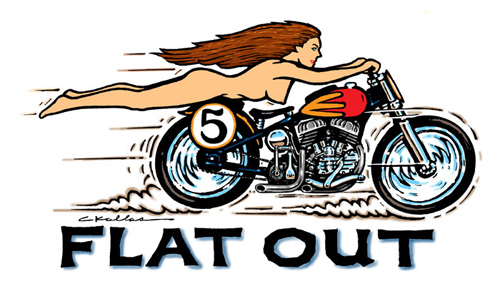

HEADGEAR RECOMMENDATIONS FROM A BIKERNET READER–I've written the few of you that I thought might appreciate quality racing gear. Tee Hee.

I'm not sure if it's SNELL approved, but I think I found the perfect helmet for use at Bonneville.Can you imagine showing up at tech. inspection….Let's see, Boots, Gloves, Leathers,….Whoa..what the F*ck is That!
–Drew Gatewood

Meanwhile back at the U.S. Choppers playground the frame began to take shape. “The kids were cranky and of course, as all youngsters are, lacking many things for us to finish,” Rick said. “No 5/8-inch tap in the whole shop! This stopped the rear end fixture we needed to make to produce a frame this length. No front motor mounts etc….. next Saturday.




Aces handled U.S. Choppers first run of Street Platform frames and we have become friends since. Both Marcio and Luke are good guys who deliver what they promise. “Their sense of humor is a bit strange, though, and I really feel they should get out more,” said Rick. “Four of us worked on a Saturday to see this Bonneville bike come to fruition. Rick, Marcio, Luke, and Lunger (our machinist friend who is suffering from some serious flu type symptoms). He had to operate the machinery without medicine for safety sake.” The four musketeers will join again for their next epic battle (next Saturday)- stay tuned!

CONCEPTS FOR SPEED FROM JOEL PEVEY– No offense, but Chris Kallas' last drawing was a bit scary — it is his best 'to-scale' drawing yet, but 2 feet over length? – see drop tube angle – motor can be positioned much farther fwd, with legs more towards the vertical, but we'll need to review rider position and using ballast in more detail later.
Again no offense – his latest is already an improvement on last year and will be workable if that is what you have decided on already.It’s not 2 feet over. Actually it will be stretched 6 to the rear and 8 to the front.
Rick Krost had mentioned possibility of going with a dual downtube, a two-leg frame. Might want to take him up on that. Dual top tube also, at least from center post back?? Will explain why later. Can also get sketches to you – too bad I can't draw for shit, but I'll do the best I can.

GET WITH BERRY ON FINAL DIMENSIONS OF MOTOR. I know you gave Rick the dimensions of last year's motor, but didn't Berry say this “ONE OFF” will be very different? The engine dimensions determine EVERYTHING else. Engine 1st, VT20 second.That was handled by Berry directly with Rick, Admiral.
WHEN ARE YOU FLYING VT20 (Valerie Thompson, our Go-Daddy Rider) out for fitting to frame? That is our first real HARD TARGET DATE.- Any other dates or schedule known? Test dates at El Mirage, for example? Just asking.
However, would YOU like to tech the bike and take it for a couple runs the day before VT20 shows up? When it comes to feedback on handling, balance, controls, etc. There is nothing like first hand experience. PLUS, it would make for great Bikernet content!!! What the hell – get Bates or Vanson to donate a set of leathers with Bikernet and 5-Ball Racing graphics all over them, and go for it!!

Our plan is to have Valerie fly out in about three weeks for our initial fitment and moulding party. We’re going to cover her in foam and push her around the block. Hang on for that.–Bandit

UPDATED FRAME DIMENSIONS FROM CHRIS KALLAS–Here's a crack at modifying the fork angle. I cut-n-pasted the wheel back towhere you'd have about 3.75 inches of trail. Guessing the fork angle at about 32 degrees.Wheel base comes to approx. 81 inches instead of 85. Depending where your at withRick and Leo's progress this could be a moot point, plus this is based on mypreliminary frame dimensions. May still be a glimpse of what it might look like.
–C. Kallas

LEO’S RESPONSE TO THE NEW DRAWING– This will work into the plan perfectly. What we have been heading toward, will now come to life by adjusting my relations of upper and lower control arm length to each other thru the eccentric in the control arms then moving the shock so the control arms run parallel to the earth I will build more trail and get wheel closer to the power-plant of the bike to decrease the size of the perpendicular thru-air pockets effectively making it more like a streamliner as we have been discussing . Good work. I'm still working on the note from my mom.
–Leo DiOrio

Assalt Weapan Bonneville 2007 Effort, Chapter 2
By Bandit |


Okay, we had a plan, like a musician with a blank sheet of music paper and a rhythm running through his mind. I had a notion based on every element I absorbed on the salt in 2006 and a myriad of conversations since. Time is also a constant obstacle and since I’m a deadline freak, I set one. I wanted the roller, frame, wheels and front end in my hands close to the end of the year. At this writing session, in my unheated shop the day after Christmas, with a dinky desk warmer blowing under my chair, I have six days left. No pressure…

My first wheel guy bailed and I’m waiting for a call from Kim Hotinger regarding American and Renegade Wheels. Leo DiOrio, Leos Custom Cycle Supply,Ph# 303 438 8991, is poised to fabricate our girder front end, to deliver the exact trail requested, and Rick Krost has a frame in stock from U.S. Choppers, to be modified, but we needed to nail down our plan, which is critical. We must determine the stretch behind the tranny and up front so Valerie Thompson will be poised for 200 mph on the salt. She must work with the machine’s aerodynamics for the best speed, comfort and safe handling. We're not asking much.

We are extremely fortunate to have an excellent team behind us who are ecstatic to dig for precise performance information. Our concept drawing slipped through a number of stages behind the talented hands of Chris Kallas our 5-Ball Racing Official, accredited and sanctioned artist. With each rendition I submitted the most-excellent art to Berry Wardlaw, the Accurate Engineering engine master, Leo DiOrio, Wil Phillips and often Rodan from the SCTA, for rule requirements. Below you will stumble on thoughts from various team members regarding girder handling, Valerie’s measurements, the engine and the concept progression from art to actual measurements.

Leo DiOrio On Girders:
I am ready to start doing the front end, so when the frame is finished, and we have some tire diameters to work with we can do the actual geometry. I will make some recommendations as we go down that road here is one or two of many things we should think about as we go so the whole thing comes together nicely does the frame maker have any models or prints or samples of the neck he uses? This will aid in the fork stop and stem configuration, also has Valerie given you any input on how much steering effort goes into driving on the salt the reason I ask is if we want to do something special in the the way of handle bars I would make provisions for that in the top clamp. I would think this might come into play when mocking up her riding position to create the mold.

I won’t throw all girders into this discussion without studying a few (how they work trail wise category) however I can tell simply how this one works, and here are some key points:
1. the center of the wheel is much further ahead of the centerline of the steering head.
2. Since we have twice as many links triple clamps and control arms and the shock resting within this mechanism, that isn't required to be relative in angle to the girder blades, as opposed to a conventional front end which consists of a pair of triple clamps and suspension system always running on centerline to the fork tubes. So we can increase the trail by moving either the upper clamps offset forward, or using what is effectively a longer upper control arm, or by doing the opposite of all that on the lower links (triple clamp control arms), and of course, the opposite of all that is designed to decrease the trail. With all those links and the shock position controlling the relationship angle of the suspension to the surface you are riding on, if you use all those links and shock position you can tailor the front-end to do whatever is best for the application.
There is a lot more to them, so much it will just make you sleepy.

As far as measuring it goes, as the frame gets to where we can get some dimensions, I will do all the length and trail calculations and travel requirements in the computer. This will tell me what to make, so when Valerie returns from her 200 MPH cruise, she will say it was like driving a towncar for a Lincoln commercial.
Rogers Goldammer’s bike had 5.5 inches of trail, however it’s a lot lighter than the Assalt Weapan, although Valerie is much lighter than Rodger and we are looking for higher speeds than Rodger hit. We should run more trail.
Do you and the crew believe there are faster wheel patterns than others in the world of every little bit helps? I think the fender design will effect what wheel pattern works best once you get the wheel pattern worked out I will be glad to take on hub design if you wanted It just makes sense I'm doing the front axle assembly. One last thing, and it’s no big deal.

Now Let’s Hear From Rick Krost (as in toast), of U.S. Choppers:
Dig it…… I have some crazy ideas (usually just because I refuse to listen to anyone)…. but I would like to see some 200mph bikes if you have any pics (pass them my way). I'm really thinking there is a lot of innate streamlining in my frame…. I keep looking at our sketch (nothing taken away from Chris and his art), but I think that thing will catch more wind than a sail. In my mind, I envision the front wheel tighter to the mass of the bike (i.e. more rake in trees-less in neck, or offset the wheel even).
Secondly, my thoughts on the low to the ground deal (I agree- but only somewhat)…… I would think that if you push the wind down in front- then it should stay down until exit at rear. However, there is nothing wrong with wind chasing a pattern like you see in mother nature around cliffs etc (Lake Powell)….. wind can actually increase velocity in a cone!! So my thoughts are more at directing the wind rather than just “getting low”. IE- if we direct the wind UP in front of the bike and to the SIDE, we then transition it to a point in the tail section which would mirror my frame lines- this will channel the wind into a pinpoint exit versus hitting a giant cowl and dragging.
So I picture Valerie laying down, the wind deflected just to her helmet, following down her back into a small rear “turtle” point (wind now hugging and traveling down). Conversely, the wind pushed to the side from the tire and front end gets directed not down, but across the side of the bike and frame rails then directed up the frame rails to a point on the rear “turtle” that merges it with the top wind flow, so that both directed wind flows exit at the same tip (Just like an airplane).
Regarding down force, I say we fill the camel (turtle) with sand….. with both her feet and sand over the tire- I think the rear end will sit pat.
Heck, I don't know, just a thought to throw your way. Let me know what your thoughts are…. remember I'm a ghetto mechanic.
–Rick
U.S. Choppers
2039 S. Lyon St
Santa Ana, CA 92705
714-546-4699
Appointments Only Please
http://www.uschopper.com/

Here’s Berry Wardlaw of Accurate Engineering on The Engine:
The engine I am building now is NOTHING like your street engine. I'm really shooting for over 200 hp. Now that's pressure. I have gathered a mountain of information and John (Andrews) is building the camshaft but he is also doing 4 other custom grinds and the Crocker cams, so I know that will take 5-6 weeks. I do however have your heads, the titanium valves, springs, etc…”
Reliability is why I am taking pain staking measures in machining, assembly, reading, asking questions, researching, etc. We can't win if we can't finish. The aluminum rods will absorb some of the shock load when we hit the 100-150 hp shot of nitrous. We will definitely work the nitrous loads up VERY carefully. Remember we need two exhaust gas temperature gauges, one for each pipe, so when we hit the nitrous she can watch the temperature to make sure the nitrous is working. If the nitrous fails she will simply let off the button.
I am on my way home to finish the last details of the engine on the computer then on to the flow bench. Aluminum, titanium, magnesium, beryllium, nitrous Panhead. Say that three times fast. No word yet on my/your cam from John. This is going to be the nicest engine I have ever built, God I hope it works! Hey, do we get to ride it after the “Girl”?
We are working with S&S for the following components although later, we discovered, some of the elements didn’t fit into our formula.
1. Aluminum rod set, 8.000″, .927 wrist pin. #34-7222.
2. 1.500″ tapered crank pin w/nuts for 1981-up flywheels. #34-2180.
3. 1981-up 4.500″ stroke flywheels, stock diameter for 1.500″ crankpin.

Talked to Mil. I already had the S&S ignition and the reverse gears for your engine. Right now I am trying to hustle S&S out of a set of aluminum rods, Axtell out of some free cylinders and blank pistons. Hell, I'm lookin' fer' anything free.
–Berry

We are working on an article about Berry's engines, his performance philosophies and guidelines for a 2007 Panhead motor. Hang on for that one.
–Bandit
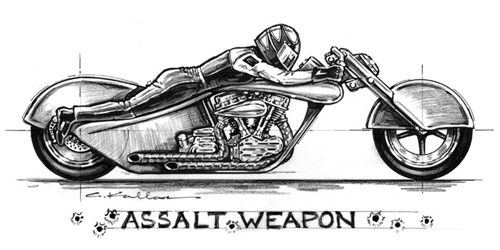
The V-Rod Connection:
I can tell from the art that the possibilities for great things are emerging. Are you still planning on not using a front brake? A V-Rod headlight might make for some good streamlining based on its shape. Not that it is any of my biz except if you use a headlight I should make provisions to mount it.
Ask the frame maker, if between 32 to 34 degrees of rake fits into the plan. We can achieve the desired trail with almost any rake; however if we keep the rake in this range, it will make the gap between the rear of the front wheel and the front of the motor smaller to help with the overall aerodynamics.
–Leo DiOrio
Leos custom cycle supply
Ph# 303 438 8991



Thoughts from A Bonneville Veteran and Bikernet Reader:
I have had the privilege to work thestart/finish line at the last 2 BUB events. My Dad and I ran the 8 mile lastyear and I was at the 5 mile in 2005. I have been keeping in touch withValerie via E-mail since the last BUB event and I would love to see her getinto the 200 MPH Club.
The fact that she could do it with a Panhead motor would make it that muchbetter! I have been reading about the (Assault Weapon) concept bike on yourweb site and I think you are on the right track to achieve your 200MPH goal.Aero + HP + traction = SPEED.I have 2 ideas you might want to think about.
1) Traction:John Noonan on his recorderd setting Hyabusa, (almost 260MPH) attaches 175lb of lead weight on his swing arm to gain more tractionon the salt. Every bike will hit its “Aero wall” and no amount of HP willmake it go faster on the salt. The rear tire will just break loose. Valeriehas many talents but weight on the rear tire is not one of them.
2) The rules say you can only Streamline the bike so much. The rules do notsay how much you can streamline the rider. It would seem to me that a ridersleathers and speed hump could be fashioned to create more down force on therear tire and still be slippery in the wind.
Wishing you the very best of luck at the 2007 Speed Trials by Bub, and Ilook forward to seeing you on the salt!
–Bob
“Robert Collier”

Okay, so nailing down the actual configuration for the Assalt Weapan involved one critical aspect, Valerie’s size. We needed to see if my creativity abilities and actual measurements worked together. Snagging dimensions from a woman is a chore, but she finally came around.
Valerie Thompson On Measurements:
Okay…I'm doing it right now. I just forgot measurements from where to where…?
I'm5'4 3/4, 105-110 Lbs, hip to ground 38 inches, helmet to hip 3, shoulder to fingers 29. Does this help..?
How about this: 68 inches with helmet, 31 crotch to shoe, 22 shoulder to wrist, and 16 shoulder to shoulder.
Is this good?
–VT

Once the measurements were forthcoming Chris Kallas and I started working toward a scale drawing. Rough measurements indicated dismal results. We might be forced to stretch the frame a foot forward and a foot to the rear. That concerned me from several aspects. I didn’t like the notion of a flopping chain, and I was severely concerned about frame flexing, although Rodan assured me that the longer a frame is the more straight it goes. I still prayed for a tight extended frame. Then Rick Krost poored forth his philosophies:
Lets say we are around 68″ wheel base to start…. then we add 12″ getting 80″ wheelbase…….. after that I would figure we would need a truss type frame (like a drag bike) for structural integrity like you mentioned before. If we go a foot on each end, we are in the 90-100 inch range which would necessitate a bridge type truss system. No matter what, we can still add stanchions in the rear and a dropped double country bar in front and rear of the motor. How many hp per inch is Berry getting us and what size motor (I am figuring normally aspirated pushrod?). It’s all reasonably easy- we just have to start at the right place!
Figure in the early days they were going 150 on little spindly frames with tiny motors and short wheelbase (and open wheels)….
It was in 1969 that Payne’s Turnip Eater set several records, including hitting a top speed of over 201 mph, en route to an average of 196.512. His trap speed of 201 made Payne the first rider in history to push a non-streamliner to over 200 mph. His bike was towed up to 70 mph before he fired it up to begin the run. To save weight he used a single-speed transmission, which meant he had to slip the clutch up to about 110 mph. That year he broke the existing class record by a margin of 43 mph.
Stock Jap bikes are coming in at around 175…….Plus you have 250mph Hayabusa's that merely have an extended swingarm and a hopped up motor……(open wheel), but then again they say it takes 8 times more horsepower to go twice as fast….. so does this mean we need 4 times more horsepower from that same motor by the same metrics???

But seriously, lets break it all down….. we are friggin pussies if we can’t do this…… here’s why:
Fastest Bicycle Speed
The highest speed ever achieved on a bicycle is 268.831 km/h (167.043 mph), by Fred Rompelberg (The Netherlands) at Bonneville Salt Flats, Utah, USA, on October 3, 1995. His record attempt was greatly assisted by the slipstream from his lead vehicle. Fred has been cycling professionally for nearly 30 years and during that time has held 11 world records.
Who: Fred Rompelberg
When: October 3, 1995
Where: Bonneville Salt Flats, Utah, USA
What: 268.831 km/h (167.043 mph)
I rest my case- let's pedal Bonny!
–Rick
U.S. Choppers
2039 S. Lyon St
Santa Ana, CA 92705
714-546-4699
Appointments Only Please
http://www.uschopper.com/

Memo To 5-Ball Racing Concept Illustrator:
I took Valerie's measurements downstairs and played around with a rigid frame in the shop. I'm afraid that my design is flawed unless Valerie was a midget. I figured the frame would need to be stretched about a foot forward and another foot behind the tranny. Rick Krost is also going to confirm, but see if you can check it out.
Rick told me he has a double-downtube rigid we can work with. I told Rick we may have to stretch it 6 inches to the front and rear and see if we can work with that. The rule book states that the controls must be within 6 inches of the rear axle.
–KRB

Chris Kallas Adding Dimensions To The Concept:
I've been struggling with the scale. Are you sure that the engine is the sizes you told me.I've been measuring off of some photos of the salt shaker. When I get the right height it doesn't match the width.
You gave me 20.5″ W x 23″ H.If I use the height at 23 I get about 21.5 wide.Is the tire diameter on the front of the salt shaker approx. 26″ in diameter?If you gave me the distance from axle to axle it could help, also.

I confirmed the engine measurements. The Salt Shaker has a 66-inch wheelbase compared to the Sturgis Shovel at 75 inches. As best as I could measure around the Mikuni carb, the engine is 20.5 inches wide and 22 inches tall. The front wheel is 25.5 inches in diameter. We must run Avon W or Z rated tires and so we'll run a 17 rear 140 Azaro that's 25.8 inches in diameter. The Azaro front will be an 120/18 at 24.6 inches in diameter. –Bandit

Just a note to let you know that I've been working hard to get the scale close. Here's my composite image that is a basis for scaling the frame dimensions (below).I rotated Valerie's arms and legs to the approximate needed position from a photo of her on the Salt Shaker and then scaled it to the engine frame reference.
There are some things to consider that we will have to discuss. Right now it looks like about 8″ of stretch in the back and about 10″-12″ in the front.Rough estimate for the wheel base 85″-88″. Should have more to come soon.
–CGK

The Suspense Was Killing Us:
Here's the first real try at figuring this thing out.I worked Christmas eve till 2:45 am to get this done for you before I skip town.
A few notes:
1. Remember don't take the axle back/up and neck out/down measurements literally as my baseline may not be the same as the frame you start from.
They just give an approximate idea of stretch. Just use the measurements from the engine mounts and the ground.
2. It will be critical to know exactly how tall your engine is to make sure you can get it in the frame.
3. Fork rake and neck rake will need careful consideration. There is zero trail as it stands which seems dangerous. The arms on the fork are probably a little too long, but it appears that if even they were shortened a bit you still won't have enough trail. You'll need to consult.
Leo on these matters. I suspect you will want more neck rake with negative rake in the forks.
4. Foot peg position is 2″ back and 2″ down from the axle. This can be adjusted for comfort, leg aerodynamics, or body position. These things could affect where we finalize the frames neck position also. We'll need to discuss further.
5. This is just a drawing, and I did my best to make Valerie to scale without have her here in person to measure. Will she really fit in this position and be comfortable?
6. Tire diameter for rear tire was rounded up from 25.8 ” to 26″ for ease of drawing at this scale.
7. Top frame tubes could use a design where they crisscross the front legs which would make for a lower backbone.
8. It would probably be best to come to my place so when we make changes we can do it on the computer or in my studio.
9. Merry Christmas
–CGK


California Customs Bagger Effort-1
By Bandit |

So it begins…..I’m not sure when I finally decided to start designing one of our custom bagger models for a run at Bonneville, but I guess it had been rolling around in the back of my mind for some time. As a kid I remember seeing streamliner cars like Spirit of America and The Blue Flame make a run at land speed records. Maybe that started the seed way back then. Having been on two wheels since I was just a wee lad I guess I was somehow destined to be in the motorcycle business in some form.
As a teenager I was always looking for ways to make my cars faster and at the same time I was involved with racing motocross, so bikes and speed were always there. My dad was a mechanic and knew his way around a motor better than most I’ve known; so when I sit back and think about all of those influences, I guess eventually it made sense to build something to try and go faster than anyone else. That’s the origins of speed to me. Someone always wanting to go faster than everyone else can, whether it’s on foot, in a plane, in a car or straddling two wheels and whole lot of horsepower..
I’ve always been fascinated with Bonneville or at least it seems that way. I remember the Easyriders magazine bike going for the speed record in the streamliner class and I donated money for that cause. I was tired of a Kawasaki holding the record myself, so it seemed like a good cause to donate some extra cash to. I guess as we get involved with living life and supporting our families sometimes we lose track of the things we dreamt about as youngsters and I’m no different. For the past 16 years I’ve been pretty busy with running a custom motorcycle shop and all that entails as a business owner in an ever-increasingly competitive industry. I always enjoy building bikes with serious performance, so hot rod bikes seem to be what I like building the most.
My personal bikes are built to be able to move quickly, so the speed thing is still there.
So then it came to me. I’ll be honest and say I’ve been influenced by some amount of competition. I saw Brian Klock’s bike and read about his attempts at having the world’s fastest bagger. I’ve also been reading about the Bikernet’s 5 Ball Racing Panhead venture and sent in some sponsor bucks for that bike.

Having respect for others in my industry I felt compelled to make an attempt to build a bagger worthy of competing against the Klock Werks record. I’ve been building a custom bagger style bikes since 1997, something no one else has been doing that I know of. Our Nomad model is a collaboration between California Customs and Corbin.
Corbin designed and produces the front fairing, chin spoiler, front fender, rear fender, saddlebags and seat just for this model. Our goal was to be the first to build a true custom bagger with no H-D style or replica parts. Mike Corbin and I came up with this idea over dinner one night in Laughlin.

The Nomad will be the base we start with for the Bonneville Bagger or as we’re calling it in the shop, Bagzilla. To get started with the project we asked some of our long times suppliers for help with sponsorships on this project. The guys at Daytec were the first to climb on board and have sent us the frame you see pictured. Also helping out so far is Belt Drives Ltd with their primary drive and a final drive belt. Hacker Pipes is also on board and will custom design a pipe for the bike when we get to that stage. We’re still looking for sponsors for our drivetrain and wheels. We’ll be posting pictures on our web site too along with the list of sponsors. Check it out at www.calcustom.com


Bikernet 2007 Bonneville Sponsors
By Bandit |

We’re hot after another record and interest is high. Hell, we haven’t peeled all the salt off the Salt Shaker and already the pressure was on to return to the salt and make our own title: The World’s Fastest Panhead. Berry Wardlaw, the mastermind behind the Panhead Powerplant designed the new engine before we paid for our 2006 Bonneville hotel room. Chris Kallas, the 5-Ball team concept designer, assigned the name before we had a chassis manufacturer lined up. It was destined to be the Assalt Weapan and you’ll see the progression of illustrations below.
That’s not all. We now have the parts to piece together a Bonneville 45-inch flathead attempt with a K-model top end and original racing cams. Departure Bike Works is rebuilding the engine and transmission while building a bike for a Discovery Build-Off. The Bonne Belle may also see the flats this year.
Here’s the growing list of top notch sponsors already on board. We welcome and appreciate all the help and support. Even Wolfgang Publications stepped up and offered to publish a book on the Bikernet 2007 Effort. All the articles published on Bikernet will also see the book stores through Wolfgang and Tim Remus.

PLATINUM LEVEL****************************
Accurate Engineering

GoDaddy.com

David Florence, Bikernet Reader
Custom Chrome

Baker Transmission

Departure Bike Works

Paughco Frames


GOLD LEVEL**************************
BDL

True-Track

D&D

Lucky Devil
Pegasus by BDL

Chris kallas


Jim’s Custom Paint

Scooter Grubb
CustomRodGauges.com
Lucky Devil Metal Works, Houston, Texas
Duane Ballard Seats



SILVER LEVEL*********************************
Renegade Wheels

LA CHOP RODS

NICK'S PERFORMANCE

All American Wheels

S&S

Spyke Starters

Avon Tyres

Ted Tine
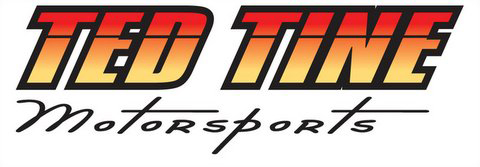

Kris from Cooler Scooters Direct.

Hank Hill
Bronze Level******************************
Ray Wheeler W8Less Rotors

Hank Hill
Expressive Design Stickers
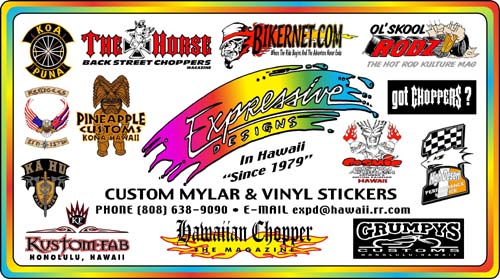
Danny Bogart
Mike Rowland
Mike & Sandy Pullin from Stealth Bike Works
Terry Anderson
Michele Stevens
Peter Gray
Peter Hagen, P.M. Fine Knives
Ian Macdonald
Steven Diehl

The Bung King Master


RIDER LEVEL****************************
Glenn and Kerry Priddle
Gene Koch
Christian Reichardt
Terry Anderson
Peter Gray
James Annand
Michael Sayles
Lynn Patterson

